Photo
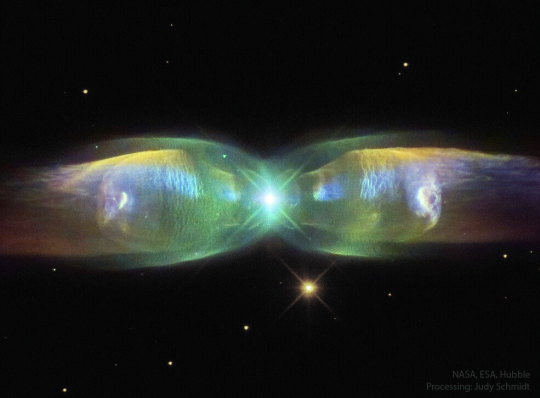
2023 April 16
M2-9: Wings of a Butterfly Nebula
Image Credit: Hubble Legacy Archive, NASA, ESA; Processing: Judy Schmidt
Explanation: Are stars better appreciated for their art after they die? Actually, stars usually create their most artistic displays as they die. In the case of low-mass stars like our Sun and M2-9 pictured here, the stars transform themselves from normal stars to white dwarfs by casting off their outer gaseous envelopes. The expended gas frequently forms an impressive display called a planetary nebula that fades gradually over thousands of years. M2-9, a butterfly planetary nebula 2100 light-years away shown in representative colors, has wings that tell a strange but incomplete tale. In the center, two stars orbit inside a gaseous disk 10 times the orbit of Pluto. The expelled envelope of the dying star breaks out from the disk creating the bipolar appearance. Much remains unknown about the physical processes that cause and shape planetary nebulae.
∞ Source: apod.nasa.gov/apod/ap230416.html
143 notes
·
View notes
Text
A Sojourn in Italia - Day 80

L’inverno è arrivato. (Winter has arrived). Technically winter began on the 21st of last month (most countries do not use the first of the month to mark a seasonal change like Australia, but rather use the equinoxes and solstices as the seasonal marker).
As previously noted, the weather has been markedly unseasonable. We’ve had some incredibly fine sunny weather, more like spring than winter. But on Saturday everything changed; we awoke to a blanket of snow. Even more so it snowed all day. By the end of the day we had a good 6-8 centimetres of depth. Delightful and perhaps potentially awkward if it hasn’t cleared by Tuesday morning. Our sojourn is rapidly coming to an end and on Tuesday, we leave our casa di vacanze (vacation house) and head off to Rome airport to drop off the car.
Anyway, we had an easy morning before trudging down the road crunching through the snow to our host’s parents place where we’d been invited for lunch. This was a delightful time with lasagne followed by meat cooked over the coals of the fireplace. Le Marche is famous for its BBQ’d meats and we were not disappointed.



Afterwards Luisa was keen to go for a short walk in the snow, so after a token snowball fight (by sheer number of direct hits I won), we walked up the road towards the contrada about 1km up. The road had clearly been ploughed earlier, but the snow was continuing to fall and while some cars were using it, I’ve no experience with driving on snow so felt quite nervous.


At first the weather report was threatening more snow with some rain, but nothing seemed clear and the forecast changed several times during Sunday. On Sunday, the expected rain became a mix of rain followed by a top up of snow. This morning (Monday) the promised rain was an even heavier dusting of snow. Nevertheless, the snow is slowly melting and no more is predicted, at least not while we’re still here. The small road from our house has a track worn in by a neighbour (150 metres downhill), and the main road has been ploughed, so fingers crossed we’ll be fine. Just to be sure, we got out the chains that we’d purchased back in Rome (legally we have to have them or thermal tyres between mid November through to mid April). We examined them and watched a couple of YouTube videos to make sure that we know how to fit them if need be.
By the way, in case your wondering why there’s been no blogs from either of us, well after getting back from our trip through Puglia, we’ve largely been taking it easy here. We’ve been quite domestic. One of Luisa’s cousins and husband spent a weekend with us and we revisited the paper museum, showed them Sassoferrato and went for a walk in the hills around Genga. Luisa’s been cooking up a storm which has been delicious but not so good for our waistlines.

On Tuesday we go back to Rome for 4 nights, stay at an airport hotel for Friday and fly out on Saturday. So our sojourn really is coming to an end.
As Luisa’s blog says, part of our reason for this holiday with this particular approach was to get some sense of the difference between living in Italy versus the classic tourist experience. We’ve been considering a longer sojourn for some time (1 or 2 years or longer). While this is definitely possible, it’s got some practical difficulties and after careful exploration we’ve decided that shorter visits are a better option for us. I’ve got some interesting observations and thoughts arising from this experience, but I need clear space to write them. I might get to do a short blog in Rome, but either way, I’ll have a wrap up after we get home and talk about my observations and the experience.
2 notes
·
View notes
Text
23 gennaio - Update

Our stay here in Le Marche is coming to an end. While we’re finally getting the experience of snow, I’ve been very nervous about driving back to Rome tomorrow given the snowy conditions. I’m feeling a little more reassured today, after we’ve watched several YouTube videos on how to secure snow chains, and Allan has done his research on driving in the snow and spoken with his son who has driven in Canada. I also watched one of our neighbours at the bottom of our road – they’d stopped to put chains on their car in order to travel the 150-200metres up the road to their house which is very close to ours. Seems much more doable when the locals are doing it.

A major reason for coming to Italy for an extended period was to work out whether we could live here for 1 or 2, and potentially even move here permanently. After much research we’ve worked out that while we could make the move, it isn’t practical for us. So it’s really hard, and I feel particularly sad, that our neighbours here have flagged the house next to ours as available and as a really great bargain and ideal for us here. I think they (the parents of our ‘hosts’ here) would love to have another set of neighbours living close to them.
And we’ve had some lovely interactions with the locals in Sassoferrato – one with a woman in the post office who worked for about 15 mins trying to find a category for the two gnomes I wanted to send back to Australia (we finally settle on ‘giocchi’ or games – the gnomes were made by a cousin and they are just stunning). And then there were the two women in the fruit and vegetable shop who farewelled us with “ci vediamo presto” (we’ll see you soon); they were disappointed when we told them that we were returning to Australia soon. One of them told me about having relatives living in south Sydney who have sent her koala skins (I think they may be kangaroo skins) and ‘balls’ – she did mean scrotums which are often seen made into change purses in Sydney tourist spots. What a strange gift or memento of Australia – kangaroo balls!!!!!
Now it’s Monday and we leave Le Marche tomorrow and head back to Rome. I’ve been able to go for my daily walk most days (check out my photos of the snow around us) and I’ve cooked my last focaccia and torte di limone in Italy, at least for this trip …



3 notes
·
View notes
Text
10 gennaio – Lecce and the trulli of southern Puglia
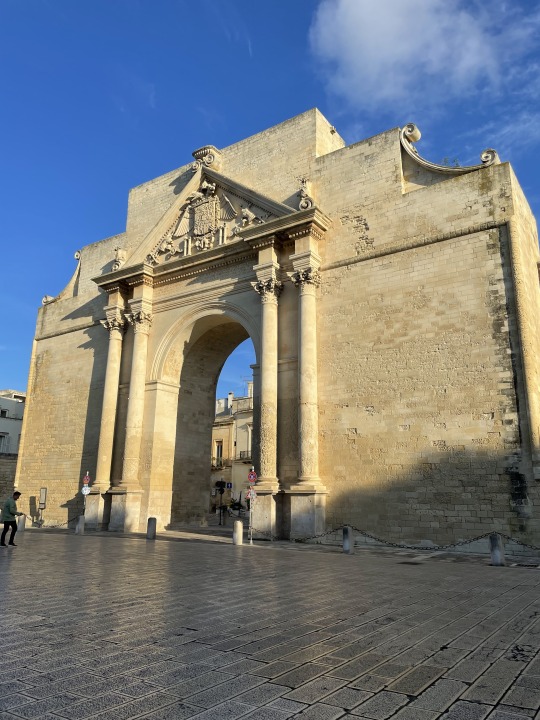
We returned back to our home in Genga yesterday afternoon, after a mammoth drive from central Puglia. I say mammoth but the distance was about 550kms which is 100kms less than the journey from Canberra to Melbourne. The drive back was relatively easy as we travelled mainly on the autostrada which meant 110 to 130km/h speed limits and a straight run through to Ancona in Le Marche.
The autostrade here are really good; there are no traffic lights or roundabouts, there are, instead, lots of tunnels where the road either goes through a mountain or under a small town, and massive bridges over ravines. I did finally try out the 130km/hr speed on a particularly good bit of road with few other cars and no trucks, but I’m much more confident keeping my speed around 125-127km/hour. Driving on the right side of the road feels quite comfortable now and I no longer feel those sharp flashes of absolute panic with approaching cars which is a relief! Mind you, I still hang onto the seat when Allan overtakes trucks or navigates curves on the autostrade at high speed. My reticence, not his driving.
Our second stop in Puglia was Lecce, a university city with ancient roots that is often described as the “Florence of the south”. The old centro storico (the historical centre of town) is filled with Baroque architecture in a style referred to as ‘barocco leccese’. While many of the buildings pre-date the Baroque period, their facades were redesigned and adapted to this style in the 17th century. Many of the buildings have been constructed using the local limestone which glows in the setting sun.
Luckily our apartment in Lecce was quite spacious so we could relax. In addition there was a supermarket close by and the centro storico was only about a 900m walk away on flat roads. Much of our time in the city was spent either relaxing or wandering through the centro storico, the latter of which we accessed through the Porta Napoli. This door to the old city was built in the 16th century in honour of the emperor, Carlos V (Charles V).
The Castello di Carlos V which is close by, was first built in the middle ages and then fortified and strengthened by Carlos in 1539. The Castello consists of two concentric trapezoidal structures surrounded by solid battlements and a moat which is now empty. Unfortunately it was closed at the time we visited.
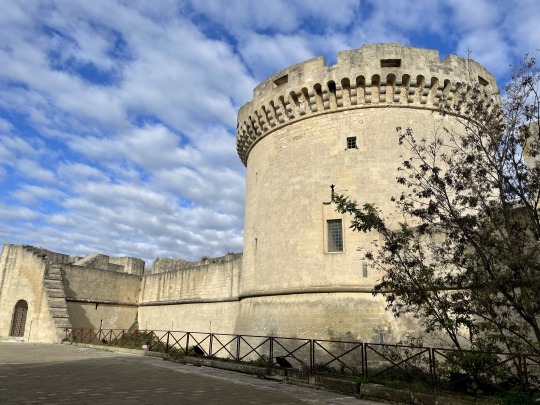

A very surprising and unexpected find for us was the Roman amphitheatre in the central piazza. This amphitheatre was built in the second century AD to hold up to 25,000 spectators. A third of the original amphitheatre has been excavated, with the remainder being buried under the surrounding buildings. We also happened upon another older ancient amphitheatre in our wanderings – another unexpected surprise.

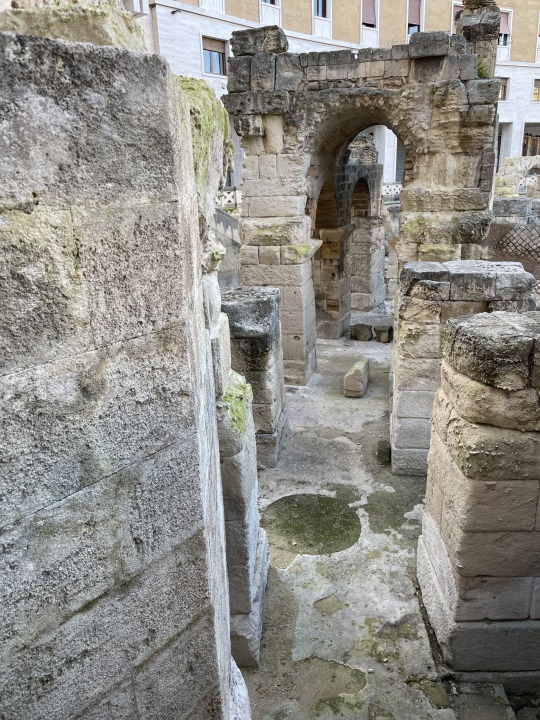

One of the amazing thing about Italy is the colocation of ancient ruins with medieval buildings and, in Lecce, very ornate Baroque facades. The exterior of the Basilica di Santa Croce which took more than 100 years to complete is an excellent example of the latter – it is very intricately and richly decorated with strange beasts, cherubs, fantastical monsters and plants. We were able to watch a short film which showed closeups of some of these forms. I was struck by a cheeky cherub trying to hold an oversized crown on its head – I’m not sure of the connection to the church but it was delightful to see. The photos we took don’t really capture this level of detail which is either stunningly beautiful or a little strange, depending on your personal perspective. I will leave you with this quote from Marchese Grimaldi who apparently said that the façade made him think he was having a nightmare.

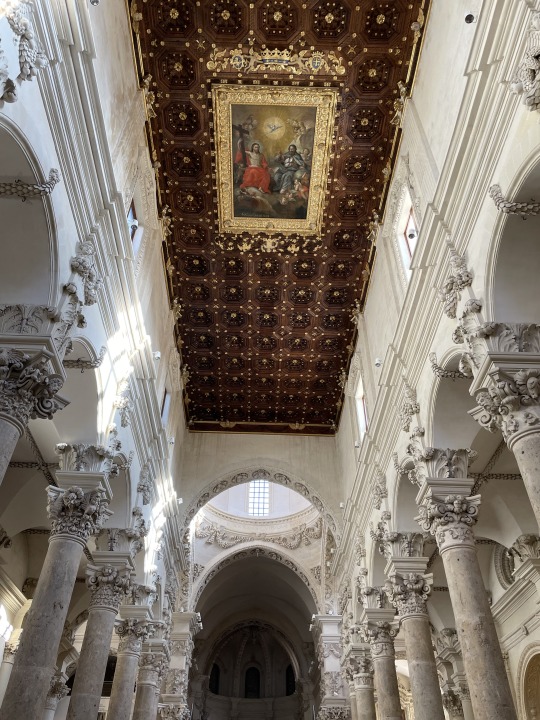
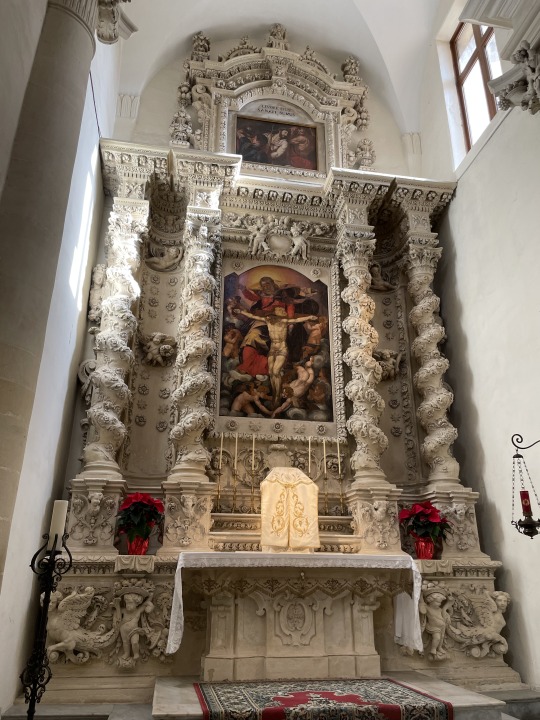
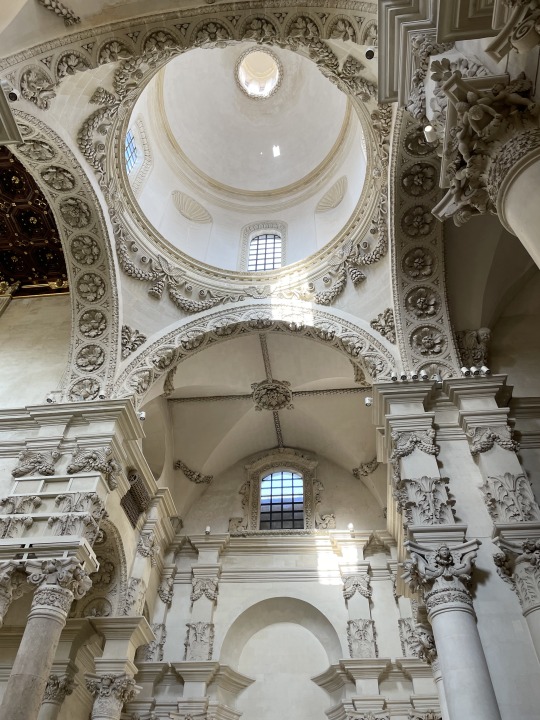
The Trulli of Puglia:
After our stay in Lecce, we headed further inland for Matera. Our intention was to stop in Alberobello for lunch and to see the famous trulli, the traditional, dry-stone huts which are specific to the Itria valley in southern Puglia. The trulli (or trullo, singular) are drywall dwellings constructed without the use of mortar and using an ancient building technique. The dwellings are built using roughly worked limestone boulders, and they feature pyramidal, domed or conical roofs built up of corbelled limestone slabs. While the roof is conical, the buildings themselves are generally rectangular in form. Many of the structures in Alberobello are whitewashed, in contrast to those we saw in the more rural areas. The walls of the trulli are built directly onto limestone bedrock and they comprise a double skin which is filled with rubble. The inner skin is domed and comprised of wedge-shaped stone capped by a closing stone, while the outer layer is watertight. Some of the trulli date back to mid-14th century.
We passed many of these buildings on our way to Alberobello, including a number of quite opulent or expensive looking dwellings on a mountain overlooking the Itria valley. These houses were either built around one of several pre-existing trulli or the ancient trulli building method was incorporated into their design. Unfortunately the very narrow roads meant we couldn’t safely stop to look more closely or take photos. Nor could we safely stop and look at the many trulli scattered across the valley – not only were the roads narrow, they were all lined with rock walls which looked quite ancient. The whole area looked surreal, almost like we’d suddenly driven into another country.
Now we had chosen to visit Alberobello because it has the highest concentration of trulli, with more than 1500 structures located in several town quarters. Thousands of other tourists also had the same idea; the place was full and we drove round and round trying to find a carpark. At one point, Allan turned into a narrow street thinking it would get us off the main streets and to a safe place to leave the car. But no, it was a one way, very narrow street right in the heart of trulli territory. Talk about stressful! I’m not sure what would have been worse if we’d hit one of the houses going through, the damage to the car or the damage to a UNESCO listed dwelling that thousands of people come to see each year and which is part of Italy’s cultural heritage ….
I got out and offered directions to Allan to make sure we didn’t hit anything, and to apologise to the locals who came out to see what was happening. Allan navigated and very, very slowly drove the car out without any major incidents or accidents (except that poor plastic garbage bin). After that, we just drove out of the town and kept going on to Matera. Thankfully we’d booked a room in a hotel in Matera that had very accessible parking. Having a car in Italy is terrific for getting to a range of different places but you really need to do your research first and to work out where you can park the damn thing when you get to your destination. (And most Italian tourist guides, Google and Apple Maps all seem to ignore parking.)
I don’t have any photos of Alberobello or of the trulli so here is a photo of a street which is wider than the one we navigated , and a link to other photos of the trulli:
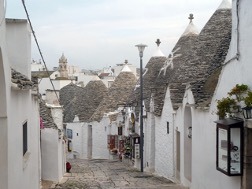
3 notes
·
View notes
Text
12 gennaio – Ceci neri di Matera
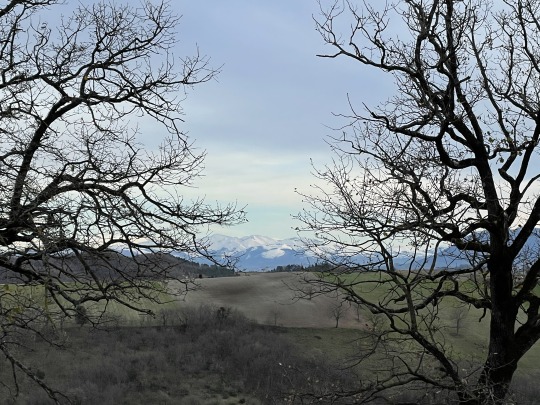
Allan is currently working on an update about our time in Matera, in Puglia. We saw so much in the 1&1/2 days we were there that it is taking some time. In the meantime, I’m posting a photo of our dinner last night. Now I don’t often post photos of main meals because the resulting photo often doesn’t look as appetising as the actual dish. This might still be the case but the dish is unusual and worth writing about.
On our first night in Matera we ended up in a little shop featuring some local products. I was very interested in the packets of what looked like little black stones. When I asked about them, the woman managing the shop said that they were ceci neri (cece nero - singular); i.e., the Murgia Carsica or Black Chickpea. She went through the whole process of how to cook them and she then very generously told me about some of the other products in the shop.
We left and started walking off but after a few minutes, I decided to go back and buy a pack of the ceci neri. I think the woman was pleased as she took me back through the process of cooking them a second time.
History of the Ceci Neri
The Murgia Carsica Black Chickpea is a rare and historic chickpea which has been grown in the Murgia Carsica region around Bari and Matera in Puglia for hundreds of years. This region is characterised by sandy soil which is particularly suited to growing legumes (and onions). The ceci were certainly being cultivated in the 19th century when they were consumed by rural families and providing poorer families with a supplementary source of protein. They were commonly eaten until the 1950’s after which their cultivation fell due to the planting of more profitable crops with shorter cooking times. Little by little, the cultivation of lentils, onions and chickpeas has begun to show signs of recovery in recent years with six farmers re-cultivating the native black chickpea and forming the Slow Food Presidium.
The ceci neri
These chickpeas are small with a rough and irregular, black outer skin and while they are more challenging to cook than the common chickpea, they contain three times more fibre and are tastier. They also contain more iron.
The thick skin of the ceci neri is what makes them more challenging to cook. In general, they require a long soaking period; e.g., I soaked them for about 36-38 hours in cold water with a little bicarb added. Following the instructions I’d been given, I then simmered them in water with salt, some olive oil, a celery stalk, a tomato (the addition of the tomato was emphasised in the instructions I’d been given) a couple of garlic cloves and some rosemary. The rosemary was a substitute for the bay leaves which is a traditional addition to the cooking liquid.
The ceci were cooked after about 3 hours (I’d been warned that they could take up to 4 hours). To make the pasta sauce, I fried a sofrito of chopped onion, carrot, celery, garlic and rosemary. After about 5 mins, I added the chickpeas and some of the cooking liquid, and I let the sauce simmer for about 30 mins. Ideally you would then blend or puree some of the ceci but squashing some of them with a fork was good enough (we’re kind of cooking in a ‘cucina povera’ in terms of the sparce cooking equipment we have here).
While I would have preferred to serve the cooked ceci with a regional pasta from Puglia (e.g., orecchiette) we made do with fresh trofie (a regional pasta from Liguria). The end result was delicious!
So here is my photo. Rest assured that the dish tasted a lot better than it might look:
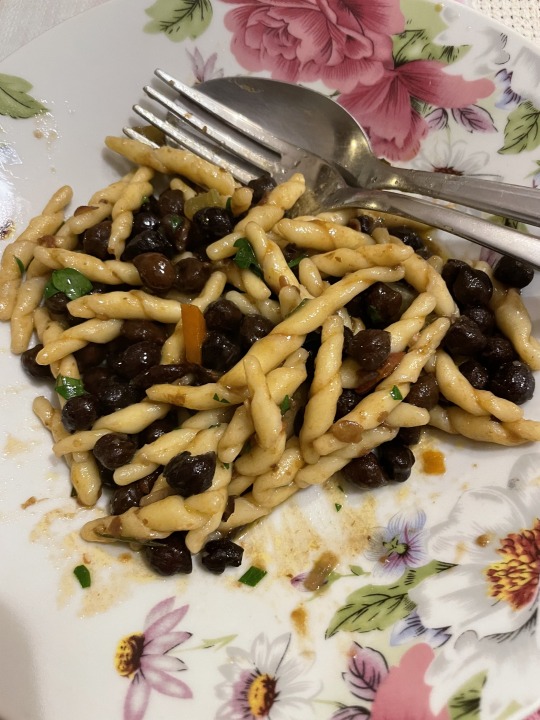
3 notes
·
View notes
Text
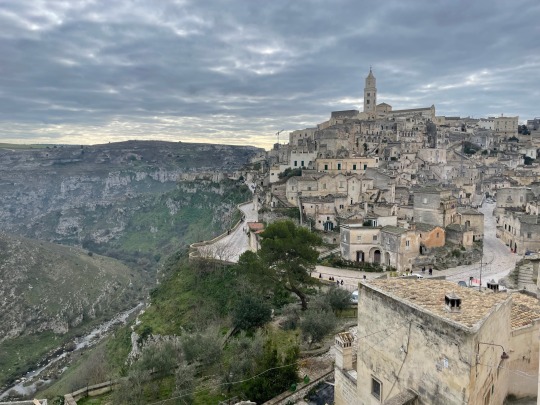
A Sojourn in Italia - Days 64 & 65 - Matera
Luisa has blogged about our drive through Alberobello and how we decided to give up and drive directly to Matera. On our way there, we were desperate to find a bar for both a toilet and for some lunch. Somehow the quiet country roads we were traversing did not have much to choose from. For example, following one sign to a pizzeria on a side road simply led us to a closed restaurant. We finally found a small bar open at about 1:30 and tried to order a couple of panini. The woman serving us apologised profusely but said that they were out of the small rolls that are used to make them and the only bread she had available was some sliced white bread (I didn’t think it even existed here!). I don’t think she expected us to accept the offer, but as Luisa said “quando si ha fame si deve mangiare ciò che è disponibile” (when you’re hungry you have to eat what’s available). The woman made us some toasted sandwiches with Mozzarella and Prosciutto. They were surprisingly good, the white bread letting the filling dominate. But what’s funny about this is while we sat eating our sandwiches, three other Italians individually refused the same offer preferring to go elsewhere. (see, sliced white bread really isn’t a thing here!)
Matera on the other hand was so good we decided to stay for an extra night. If some of the images look somewhat familiar, then you have probably watched one of several dozen movies that used Matera as their location. Perhaps two of the better known ones are the remake of Ben Hur. (2016) and the James Bond movie, No Time To Die.
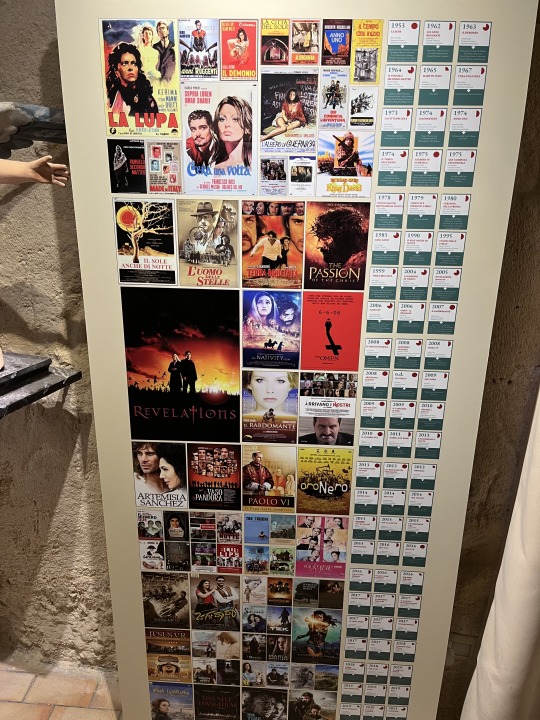
The original settlement of Matera lies in two canyons carved out by the Gravina River. This area, the Sassi di Matera, is a complex of cave dwellings carved into the walls of the ancient river canyon. Over the course of its history, Matera has been occupied by Romans, Longobards, Byzantines, Saracens, Swabians, Angevins, Aragonese, and Bourbons.

Matera is a World Heritage listed site and is most certainly picturesque, but its history is complicated. Lonely planet says that it’s perhaps the third-longest continuously inhabited human settlement, having first been settled in the paleolithic era, about 9,000 BC. It’s almost certainly the first inhabited area in Italy. As well as having abundant game in those times, the natural caves in the gorge are an attraction with the soft rock making it easy to both expand the existing caves and to create additional ones. The gorge is full of caves as are the lower sections of the main city. But in the mid 20th century, these caves were also a symbol of the poverty of Southern Italy. The region fell into poverty from the mid 1800s. In 1950, the Italian Prime Minister Alcide de Gaspari visited the area and was shocked, calling it the “shame of Italy”. He set about building new housing and forcibly moving the people out of the caves into the new homes. Only in 1962 were people allowed to reuse the caves and only if they fully restored and renovated them at their own expense. The main restoration of the area really began in the 1980’s with money from the EU, UNESCO and Hollywood!
Matera wasn’t always so poor, its had periods of splendour including during Roman times as a city either on or close to the famous Appian Way (I haven’t been able to quite clarify whether Matera was on the Appian Way or close to it, but either way it was an important Roman City). While the region was in deep poverty following WW2, its history is rich and the Sassi originally had good dwellings.
We arrived in Matera about 2:30 on Saturday afternoon and booked into our hotel. We’d deliberately chosen a modern hotel both for comfort and to keep costs low and because we did not want yet another AirBnB - some had not lived up to expectations. Our hotel was about 1.4 Km from the old city and an easy walk (no hills!). So we checked in, dumped our luggage in our room and headed off to the old city. We walked for about 1km towards what we thought was the centre of town, quite confused about the busy street which was quite contemporary, and what we’d read about the timelessness and very old age of Matera. We finally found a bar where we could stop, get ourselves an apperativo and check the maps we’d picked up at the hotel. Reassured the we were on the right track, we headed off up the road
We didn’t quite know what to expect but discovered that the Mercatino di Natale (Christmas market) was surprisingly still operating and that the place was full of people including many Italian’s who had decided to make use of the long-weekend. As the Friday was a festival day and a Public Holiday (the day of the Befana), this was a long weekend in Italy (they are rarer than in Australia as the Italians do not change public holidays to create long weekends and if the day falls on a weekend, then there’s no week-day catchup.)
As we wandered through the market, we came to the end of the road and a balcony where we could look over the the "Sassi di Matera" (the ‘Stones of Matera). It was an amazing sight - a crazy network of old, old buildings and narrow, cobbled streets. The Sassi were first settled in prehistoric times, and these dwellings are thought to be among the first ever human settlements in what is now Italy. So, of course, we set off down the stairs to explore the Sassi further. We wandered down into the heart of the tourist route through the Sassi, finally making our way up to the Duomo on the other side (the Duomo is the main church in any Italian city). The duomo was closed, so we stood with a crowd of people looking back towards the west watching the sun set.
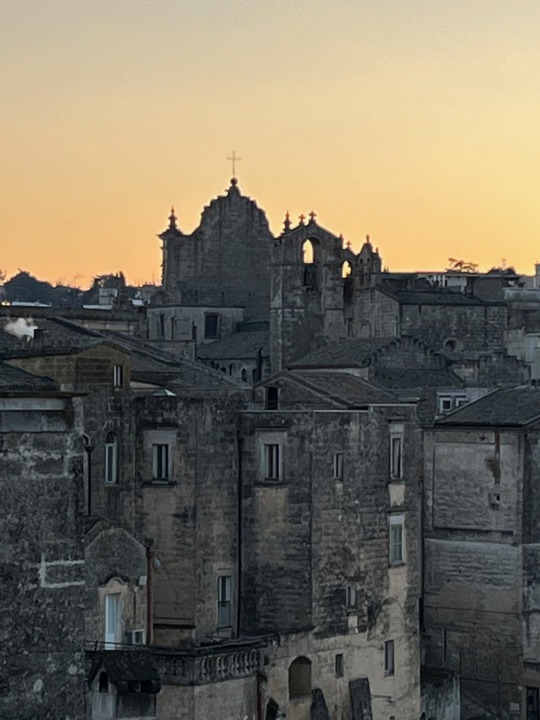
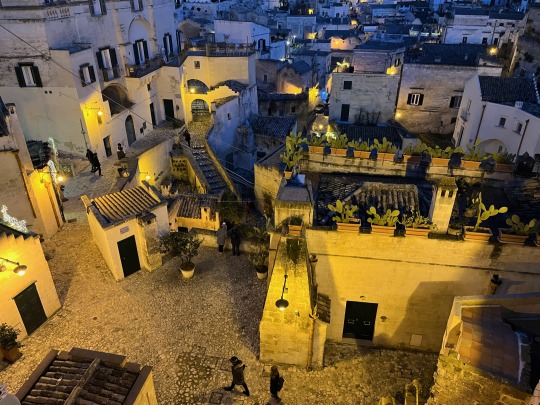
Some of the highlights of that first day:
We stumbled on the Chiesa di San Vitto al Lombardo, an old rock church that had been built in the 13th century (there are dozen of churches here in Matera which were built in the caves hundreds of years ago).
As we made our way to the Duomo, we heard the wonderful bells of its bell tower on the way. The Duomo is located in the Sasso Barisano area and habitation of this area in the high Middle Ages. The Duomo itself was built in the 1200’s, reaching completion in 1270.
We visited one of the old cave dwellings on our first day. The guide at this cave was able to give us a little information but we didn’t really get a sense of what living there might have been like.
We walked quite slowly (very rare for Luisa) because the rocky streets and stair were so slippery. I slipped on one occasion losing my footing despite wearing my Merrell boots which usually grip well. We both started slipping on numerous occasions as the paths are so worn that they are shiny. Luisa kept wondering about how many bones have been broken on these streets over the centuries.
Another church we stumbled across was the Chiesa San Giovanni Battista, a lovely old church, built in the 13th and 18th centuries. We spent some time in the church, listening to two musicians practicing on the organ and sax. It was peaceful, lovely and an appreciated break from all our walking.
After the sun set we decided to head back to our hotel and hopefully find somewhere to eat along the way. We were having no luck on our route until we passed by a panificio (bakery) specialising in sour dough. The has been operating since 1890 and is currently run by the great grand daughters of the original baker. We feasted on beautiful sour dough focaccia topped with artichokes and mushrooms, and a prosciutto and cheese strudel. The panificio was Il Forno di Gennaro.
Day 2:
The next morning after a satisfying breakfast at the hotel we set off to explore various parts of the city. Expecting to follow one route, we found ourselves going our own way to join the route we’d originally planned for the second part of the day, at its other end. Mainly we walked a route around the edge of the town, but we also revisited parts of the centre.
Some standouts in no particular order:
We visited another cave dwelling. This one was different to that of the first day being set up with a video and laid out like an original family dwelling. The video was a description of the life of a man who had lived in the cave as a young boy, his recollections of his life and homage to his father. The dwelling was set up with all the furniture and models of animals that the people who lived there would have raised. While it looked clean and fresh, the reality for the family which resided there would have been very different: the whole family lived and slept in the one room, with one bed for the parents and the eldest child. The other room had a single bed for another child and the baby slept in either a small crib or sometimes in the drawers of the old dresser. The second room (with the single bed) was for the animals which lived right there with the family - chickens which ran around the house, the donkey and a couple of pigs.
From the late 1800’s families in these cave houses lived in absolute poverty. As noted before, the government stepped in in the 1950’s and moved them to more modern accommodation. It’s hard to imagine what that process would have been like; to be taken away from everything that was familiar including the local community and probably their animals but to have access to a healthier and larger living space.
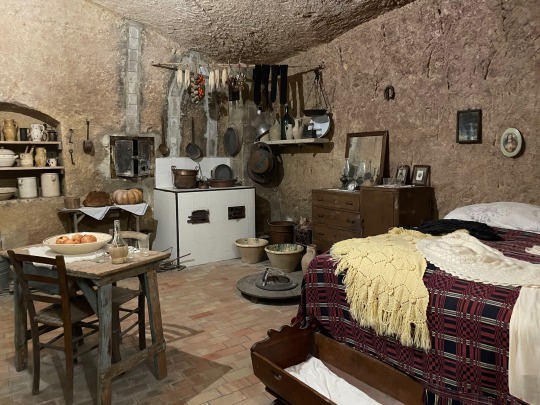

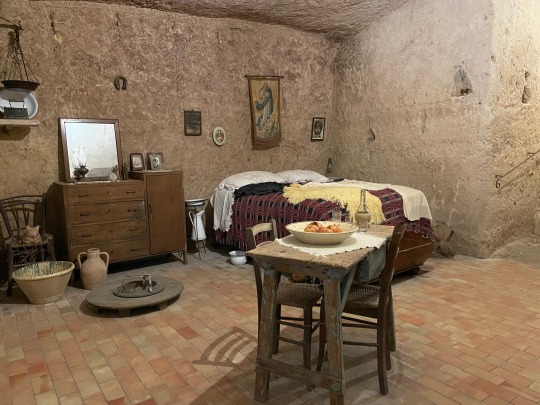

This article from the Guardian in 2017 gives some more information about these forced moves and how the Sassi have been revived - largely at the behest of a group of children who remembered the community values of the Sassi as well as the poverty and fought to have them restored. See:
To our surprise we came across several Dali statues during our walks. These were unexpected and a delightful surprise. As far as I can tell, the Dali exhibition in Matera was set up as part of it’s role as a European Capital of Culture and I think the exhibition was meant to be shown in early 2020. Of course Covid shut all that down and it seems that the exhibition has been held over to 2022. It’s destined to finish at the end of January 2023, but I suspect that the major works that have been set up in the piazza’s may be destined to remain they sure look permanent.
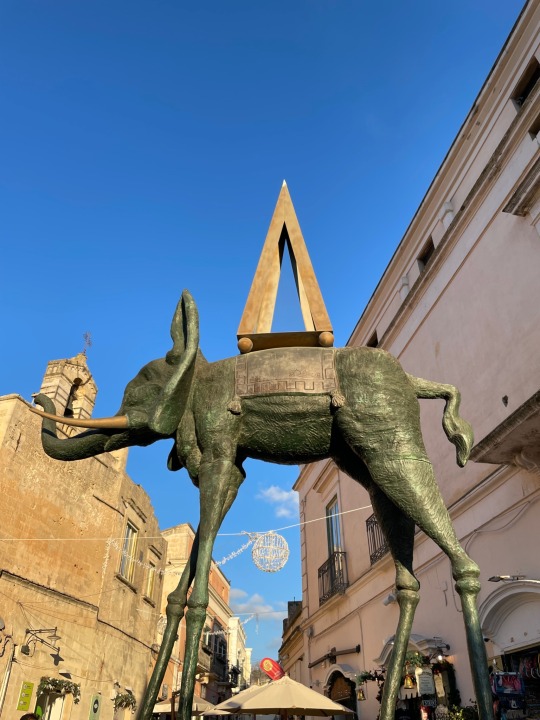
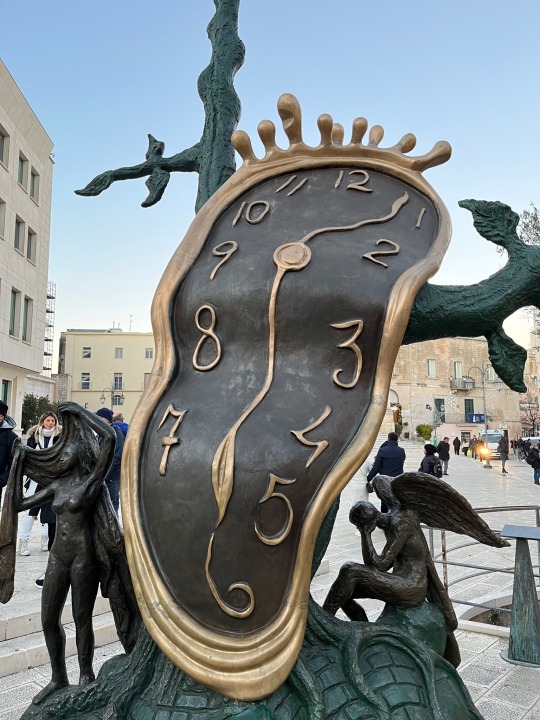
Another surprising find was a gallery of Nisio Lopergolo. As we walked through the Sassi, I noticed a couple of wooden carvings in a side street and we wandered up to have a look. Signore Nisio Lopergolo invited us into his gallery which is within one of the original cave dwellings. Nisio is a ceramic artist and sculptor and his work is very different to many of the other workshops/shops around Matera. He is an artist and he has received awards for his work. The pieces were stunning and also fascinating, and he took the time to explain some of the pieces to us.
One such piece which Nisio showed us was the Coppa di Pitagora (Pythagorean cup) or Justice cup. This cup is reputed to have been invented by the Greek philosopher and mathematician, Pythagoras, who wanted to convey a message of fairness to his countrymen, urging them to not be greedy but to be fair and balanced. The cup can be filled up t a certain point marked inside, but if it is filled beyond this point, all of the liquid is expelled completely through a hole at the bottom. As they say, “Grasp all, lose all”. Another design was a wine decanter that delivered a precise amount each time you pour out from it.
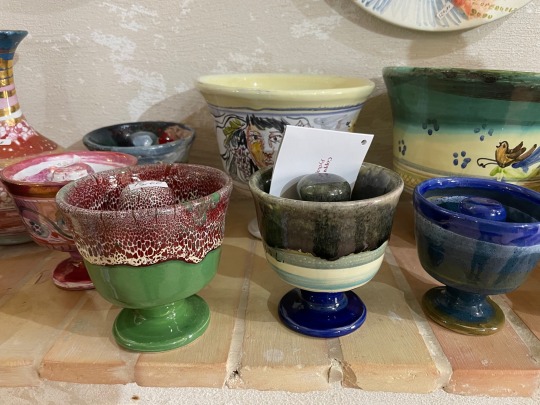
Nisio has carved figures into the walls and ceilings of his cave - you can see some of the figures on his website.
Later we made our way to the edge of Sasso Barisano, Civita, Rione Pianelle and Sasso Caveoso. We could see the caves on the other side of the canyon, and the paths leading down to the bottom of the canyon and over to the other side. Luisa was briefly tempted to walk the winding track down and over to the other side but it was only a very fleeting thought (we were both pretty tired by then).
Finally it was time to find a restaurant for lunch. But what we had forgotten was this was domenica (Sunday) and it seems that most Italians go out for Sunday lunch and booking a table is mandatory to secure a place. After unsuccessfully trying several restaurants including some rather pricy options, we finally settled on an unassuming bar/cafe, mainly because it was the only bar/cafe we found that advertised meals other than taglieri (platters of salumi and cheeses). Well weren't we in for a treat! My dish was a fantastic dish of Italian sausage cooked with carrots and cabbage in a paper wrap. While perhaps sounding unassuming it was wonderful. Luisa on the other hand, tried the baccala. Baccala is a dish made from dried salted cod and is not a traditional Puglian dish. But Luisa loves baccala and was interested in trying this variation on the traditional Venetian dish. It was delicious, with the cod being cooked lightly in a tomato based sauce (traditionally it's a cream or milk based sauce). We also tried out a dish of ceci neri cooked with wild chicory (delicious).
After lunch we walked up to the castello. Unfortunatlety it was closed and the path was very slippery. As you might expect the moat is empty but Luisa says she’d love to see a castle with a full moat!!!
We were better prepared for dinner that night. We’d bought a couple of bread rolls in the morning and we ate them for dinner - with a Puglian smoked cheese called caciocavallo, mixed lettuce and the last of our biscuits. And the chocolate we’d bought at the Mercatino di Natale which had been ridiculously overpriced and was actually pretty ordinary.
The next morning we headed back home via the autostrada. An interesting experience was at the payment gate on our exit. The machine could not read our entrance ticket (you grab a ticket from the gate on entering and autostrada and the exit gate reads this and works out your fee). We’d only noticed that the gate was broken after we’d driven in - it looked like someone had given up and driven through, so I don’t think our 's was the only ticket it couldn’t read. Anyway, you must not exit the vehicle and you must not try to back up. Help is via an intercom and in Italian. In my broken Italian I managed to explain that it could not read our ticket and eventually worked out that I was being asked to tell the man at the other end what the entrance location printed on the ticket was. He quickly entered the price manually from his terminal somewhere in the ether, the machine that couldn’t read our ticket read the credit card just fine and with the clear mechanical “Arrivederci” telling us it was fine to go we exited the gate.
2 notes
·
View notes
Text
Just to add to the details about the narrow street we traversed in Alberobello, the car has front side sensors that we’re screaming at me about both sides of the car at the same time. I had about 3-4 centimeters gap each side and the street had jagged turns. It was far from straight as implied in the stock image. The only other time I had this experience was in Thiene, in the narrow lane way entrance to Luisa’s cousin’s house. These are ‘fun’ experiences of testing my driving skills. So far I’m winning.
10 gennaio – Lecce and the trulli of southern Puglia

We returned back to our home in Genga yesterday afternoon, after a mammoth drive from central Puglia. I say mammoth but the distance was about 550kms which is 100kms less than the journey from Canberra to Melbourne. The drive back was relatively easy as we travelled mainly on the autostrada which meant 110 to 130km/h speed limits and a straight run through to Ancona in Le Marche.
The autostrade here are really good; there are no traffic lights or roundabouts, there are, instead, lots of tunnels where the road either goes through a mountain or under a small town, and massive bridges over ravines. I did finally try out the 130km/hr speed on a particularly good bit of road with few other cars and no trucks, but I’m much more confident keeping my speed around 125-127km/hour. Driving on the right side of the road feels quite comfortable now and I no longer feel those sharp flashes of absolute panic with approaching cars which is a relief! Mind you, I still hang onto the seat when Allan overtakes trucks or navigates curves on the autostrade at high speed. My reticence, not his driving.
Our second stop in Puglia was Lecce, a university city with ancient roots that is often described as the “Florence of the south”. The old centro storico (the historical centre of town) is filled with Baroque architecture in a style referred to as ‘barocco leccese’. While many of the buildings pre-date the Baroque period, their facades were redesigned and adapted to this style in the 17th century. Many of the buildings have been constructed using the local limestone which glows in the setting sun.
Luckily our apartment in Lecce was quite spacious so we could relax. In addition there was a supermarket close by and the centro storico was only about a 900m walk away on flat roads. Much of our time in the city was spent either relaxing or wandering through the centro storico, the latter of which we accessed through the Porta Napoli. This door to the old city was built in the 16th century in honour of the emperor, Carlos V (Charles V).
The Castello di Carlos V which is close by, was first built in the middle ages and then fortified and strengthened by Carlos in 1539. The Castello consists of two concentric trapezoidal structures surrounded by solid battlements and a moat which is now empty. Unfortunately it was closed at the time we visited.


A very surprising and unexpected find for us was the Roman amphitheatre in the central piazza. This amphitheatre was built in the second century AD to hold up to 25,000 spectators. A third of the original amphitheatre has been excavated, with the remainder being buried under the surrounding buildings. We also happened upon another older ancient amphitheatre in our wanderings – another unexpected surprise.



One of the amazing thing about Italy is the colocation of ancient ruins with medieval buildings and, in Lecce, very ornate Baroque facades. The exterior of the Basilica di Santa Croce which took more than 100 years to complete is an excellent example of the latter – it is very intricately and richly decorated with strange beasts, cherubs, fantastical monsters and plants. We were able to watch a short film which showed closeups of some of these forms. I was struck by a cheeky cherub trying to hold an oversized crown on its head – I’m not sure of the connection to the church but it was delightful to see. The photos we took don’t really capture this level of detail which is either stunningly beautiful or a little strange, depending on your personal perspective. I will leave you with this quote from Marchese Grimaldi who apparently said that the façade made him think he was having a nightmare.




The Trulli of Puglia:
After our stay in Lecce, we headed further inland for Matera. Our intention was to stop in Alberobello for lunch and to see the famous trulli, the traditional, dry-stone huts which are specific to the Itria valley in southern Puglia. The trulli (or trullo, singular) are drywall dwellings constructed without the use of mortar and using an ancient building technique. The dwellings are built using roughly worked limestone boulders, and they feature pyramidal, domed or conical roofs built up of corbelled limestone slabs. While the roof is conical, the buildings themselves are generally rectangular in form. Many of the structures in Alberobello are whitewashed, in contrast to those we saw in the more rural areas. The walls of the trulli are built directly onto limestone bedrock and they comprise a double skin which is filled with rubble. The inner skin is domed and comprised of wedge-shaped stone capped by a closing stone, while the outer layer is watertight. Some of the trulli date back to mid-14th century.
We passed many of these buildings on our way to Alberobello, including a number of quite opulent or expensive looking dwellings on a mountain overlooking the Itria valley. These houses were either built around one of several pre-existing trulli or the ancient trulli building method was incorporated into their design. Unfortunately the very narrow roads meant we couldn’t safely stop to look more closely or take photos. Nor could we safely stop and look at the many trulli scattered across the valley – not only were the roads narrow, they were all lined with rock walls which looked quite ancient. The whole area looked surreal, almost like we’d suddenly driven into another country.
Now we had chosen to visit Alberobello because it has the highest concentration of trulli, with more than 1500 structures located in several town quarters. Thousands of other tourists also had the same idea; the place was full and we drove round and round trying to find a carpark. At one point, Allan turned into a narrow street thinking it would get us off the main streets and to a safe place to leave the car. But no, it was a one way, very narrow street right in the heart of trulli territory. Talk about stressful! I’m not sure what would have been worse if we’d hit one of the houses going through, the damage to the car or the damage to a UNESCO listed dwelling that thousands of people come to see each year and which is part of Italy’s cultural heritage ….
I got out and offered directions to Allan to make sure we didn’t hit anything, and to apologise to the locals who came out to see what was happening. Allan navigated and very, very slowly drove the car out without any major incidents or accidents (except that poor plastic garbage bin). After that, we just drove out of the town and kept going on to Matera. Thankfully we’d booked a room in a hotel in Matera that had very accessible parking. Having a car in Italy is terrific for getting to a range of different places but you really need to do your research first and to work out where you can park the damn thing when you get to your destination. (And most Italian tourist guides, Google and Apple Maps all seem to ignore parking.)
I don’t have any photos of Alberobello or of the trulli so here is a photo of a street which is wider than the one we navigated , and a link to other photos of the trulli:

3 notes
·
View notes
Text
A Sojourn in Italia - Catchup on Day 54
& Some Climate Stuff
On the 28th of December, we decided to go to a little village called Cagli to look at a Roman bridge which I’d found details of on the web. Cagli is about 40 minutes from Sassoferrato. All around Umbria and Le Marche you can still find remnants of the ancient Romans. In fact, the whole area around Sassoferrato was significant during the reign of ancient Rome, the town was better known then as Sentium. The decisive battle of the third Samnite war was fought in 295 BC near Sentium. In this battle, the Romans overcame the combined forces of the Samnites, Etruscans and Umbrians and the Senone Gauls. This battle paved the way for Rome’s complete victory over the Samnites - a battle that had been going on for over 60 years. Over the subsequent five years, the Romans gained control over much of central Italy and a significant part of southern Italy.
So back to the bridge.




As you can see in the images it is solidly constructed with large stone blocks and no mortar. It was clearly built to last. The area looks messy because this whole area was impacted last September by a significant rain bomb event. The region suffered a downpour of 350-400mm in about 1.5 hours. This is unprecedented. As you can see, this bridge that is over 2000 years old survived.
As we were looking at the bridge from near a driveway into a house (the original pathways and museo are damaged and closed), a man stopped to talk to us. Well mainly to Luisa as she can communicate, I still struggle to hold a conversation in Italian. He owned the house about 200 metres in and talked about the damage done by the event. The stone house withstood the torrent although the complete contents of the ground floor were ruined. One of his comments about this was “this is because of the changing climate and we made this happen”.
This brought me to reconsider some photo’s taken early in our first visit into Sassoferrato, around the 11th of November. Sassoferrato was also involved in this rain bomb event, as three rivers converge within its immediate vicinity. (The road we take into Sassoferrato has an area with significant damage and we can see must have been under water). Sassoferrato was at the centre of this disaster with loss of life and significant trauma to the people of the town. These images show the damage to a complete section around the area where we often park, in a carpark that sits over the top of one of the rivers.


BTW, if your interested in seeing the flood of the area in these photo's above look at https://youtu.be/kKsQf27Vir4
youtube
Of course given Australia’s recent experience of flooding, we’re not unaware of the impacts of flooding and rain bombs, but to see this up close and to realise that areas that have not been impacted by such flooding before are now experiencing unprecedented damage is to highlight the impact of the changing climate.
While on the subject of climate change, some of you may be aware that Italy had a serious drought this last summer with it’s largest river, the Po almost drying up. While rain has built it back up, there was concern about food production in Italy this last summer. Further north, central parts of Europe, around France, and Switzerland and some surrounding regions have seen unseasonable record winter heating impacting the snow fields that provide the water for the coming summer - and of course the ski season. This has helped with the lack of gas due to sections on Russia, but it comes with a cost. Italy has had a better run of this, not reporting record temperatures, and the ski fields largely remaining open. Nevertheless, the weather has been quite warm, far warmer than we expected. This has been pleasant but of course concerning in the long run. I discovered yesterday that some 300 ski fields in Italy have been permanently closed over the last 30 years due to lack of snow. That’s 300 separate ski fields!!
At the same time as I drive down the autostrada in our hybrid Renault I’m struck by the constant row of trucks transporting goods north and south. Imagine a 3 lane highway with the right lane almost completely dominated by an unbroken stream of trucks. I look at this and wonder how Europe can ever hope to convert 1000’s of trucks to batteries or restructure its transport system to one that's carbon neutral.
I don’t want to leave this post sitting on a depressing note, but also felt a need to highlight the impacts that we’re seeing in the area. Perhaps the hope stems from a little Roman bridge in the middle of a small town called Cagli that withstood the extremes of what has been thrown at it. If the Romans could build a bridge that can do that after 2000 years, then surely we can take the actions we need to stop and eventually reverse climate change. I’m heartened by an older man’s comments about “we caused this” and the implication that we can change it.
2 notes
·
View notes
Text
5 Gennaio 2023 – The heel of Italy
5 Gennaio 2023 – The heel of Italy

One of the reasons for basing ourselves in central Italy was the relative ease of travelling down to Puglia while also being able to travel north to visit family. Post-Christmas seemed like a good time for the southern part of our travels so on 30 Jan we headed off with our first stop being Chieti in Abruzzo. It was a rather long drive, mainly because we wanted to see as much of Italy as we could and so we travelled on country roads and avoided the autostrada.
Chieti is reputed to be one of the most ancient cities in Italy, with traces of settlements in the area dating back to 5,000 BC. It’s history is extensive, spanning an Italic tribe from Sabina, the Romans, the Byzantines, the Normans, the Spanish, Napoleon, etc, through to the Risorgimento (the unification of Italy).

Chieti Alta and the centro storico of the town is located on a hill overlooking the Pescara and Alento Rivers. We stayed in a small apartment about 2.6kms out of the old centre, thinking that hiking this distance wouldn’t be a problems for us. Boy were we wrong! The steep climb would have been okay if there had been an actual pedestrian path alongside the road, but climbing up in the unseasonably warm weather with cars constantly whizzing past us wasn’t pleasant at all. Walking back down on a quieter road in the dark felt just as dangerous. The next day we worked out the local bus system which helped a lot. People around us were very helpful, with one gentleman wanting to know where we were headed and encouraging us to walk back down a steep road we’d just climbed up after figuring out we were heading in the wrong direction. We decided to thank him and continue on our way back up and down the other side of the city – which was the right place to catch the bus back. (BTW, do not trust Google to locate a local bus terminal, it thinks like the American site that it is at its heart and directs you to the ‘inter-region’ bus terminal [in US terms the interstate bus terminal]. We were unable to find a way to get it to tell where the local bus terminus was.)
New Year’s Eve was quiet with a basic meal prepared in our tiny apartment, mainly because we couldn’t find a mini-mark or supermarket close by. In contrast, New Year’s day ended up being pretty good with a drive to nearby Bucchianico, a small medieval village perched on a nearby hill, and on return a fantastic seafood lunch at an unassuming restaurant just around the corner from our apartment.
We were served by a fantastic waiter (and likely one of the owners) of the seafood restaurant – as well as encouraging us to try a range of dishes, some of which I’m sure were gratis, he suggested places to visit. A ‘must see’ local attraction he personally loved was the Parco Costa dei Trabocchi.
The trabocco, also called ‘travocco’, is an old fishing machine typical of the coasts of Abruzzo, Molise and Puglia. The earliest documented existence of the trabucchi dates back to the 18th century although some believe that the contraption was first invented by the ancient Phoenicians. The beauty of the trabocco was that its use wasn’t subjected to the weather conditions; fish moving along the ravines around the trabocco were caught in the wide nets which were lowered into the water through a complex system of winches. The trabocco are no longer used for fishing and many have been converted into restaurants.


The next stop was Trani in Puglia which, on one travel site, was described as a small, quaint fishing village. As it turned out, Trani isn’t so small but the apartment we’d booked was – it was even smaller than the loft apartment in Chieti (ouch!). The old part of the city is quite lovely, especially the old castle which was originally built by Frederick II in 1233 and later strengthened by Charles V. As well as walking through the castle, we were able to view an exhibition of artworks collected by Queen Margherita, the wife of Umberto I, king of unified Italy from 1878 to his assassination in 1900. (That’s the same Margherita for whom the pizza is named, tomato base with mozzarella and basil – simple and, according to Allan, one of the best.)






From Trani we headed off to Lecce, stopping at Polignano a Mare on the way. Polignano was a good place to stop, get a coffee and stretch our legs. One of Polignano’s claim to fame is the song, Nel Blu Dipinto di Blu(popularly known as Volare) which was written by Domenico Modugno and Franco Migliacci in 1958. Domenico Modugno was born in Polignano and one of the town piazza’s features a beautiful bronze statue of him with his arms outstretched and reaching for the sky. Here is a link to the song sung by Dominic https://www.youtube.com/watch?v=9DPAb9-Stmo&t=17s . I’m sure you’ll recognise it when you hear it.




Now it was very clear from our travels down south that the production of olive oil is one of the major industries in Abruzzo and Puglia. Olive trees stretched for many, many kilometres alongside the roads we travelled, with many of the trees being very old, some likely hundreds of years old. It was such a shock, then, to suddenly encounter rows and rows of dead trees. Unfortunately many of the trees in Puglia have been infected by the Xylella fastidiosa bacterium - more than 20 million trees in Puglia (one third of Puglia’s olive trees). Have already been infected It was heartbreaking to see and it reminded me of the vast sections of dead and dying gum trees in Tasmania.
4 notes
·
View notes
Text
Auguri di Buon Anno!

It’s been quite some time since my last post – time seems to be racing away from me.
After my last post, we travelled back up north, this time to Lombardy. After spending a wonderful few days in the Bergamo region, we returned to our little home in Le Marche to prepare for Christmas and for our planned trip south to Puglia. We set off on this latest trip 3 days ago and are currently in Chieti, in Abruzzo. Tomorrow we head off to Trani in Puglia, and then to Lecce. But first things first … here is a post about our time in Lombardy.
A visit to Lombardy
On 15th Dec we headed back up north to San Paolo d’Argon, a small community near Bergamo, in the province of Lombardy, to spend a few days with my cousin and her husband. The day started off well; we programmed the GPS in our French car and it promptly sent us off towards Perugia in Umbria. Being the trusting type, we followed the directions which led us up through the centre of Italy, over the mountains, and towards Bologna. It was a much steeper, harder route than the ‘usual’ one via the autostrade. I swear that the GPS just wanted us to traverse more mountains, this time mountains shrouded in mist and fog. Ahh, the excitement of travelling across some very high bridges over what appeared to be deep ravines – I say ‘appeared to be’ because the fog was too thick for us to see anything beyond the guardrails.
Or maybe the GPS just wanted us to traverse Tuscany, albeit a little bit of eastern Tuscany high up in the Apennines!
Back to San Paolo d’Argon and Bergamo …
Our stay in San Paolo d’Argon was jam packed with wonderful experiences, amazing food and good times with family and friends. One of the first things we did was travel into Milan to see the famous Duomo, the exterior of which we’d seen on our last trip in Nov 2019; at that time we decided against trying to get into the Duomo as it was cold and wet, the queues were long and we were pretty exhausted and getting ready to return home.
The Duomo is breathtakingly beautiful and very imposing. Its construction began in 1386 and continued for many, many years with the façade only being completed in the early 1800’s. Apparently it is the largest and most elaborate Gothic building in Italy, and the largest Gothic building whose rooftop you can walk on – we skipped this option because of the low visibility due to the fog. But we did have an advantage having visited during winter as the queue to get in was pretty short.
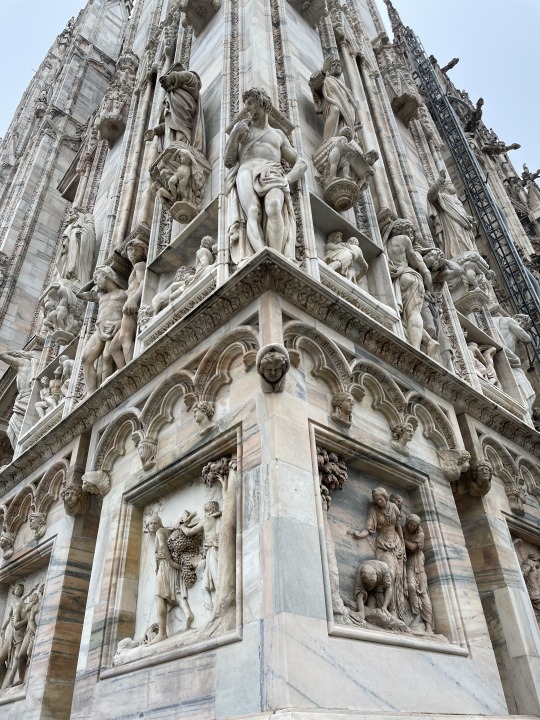




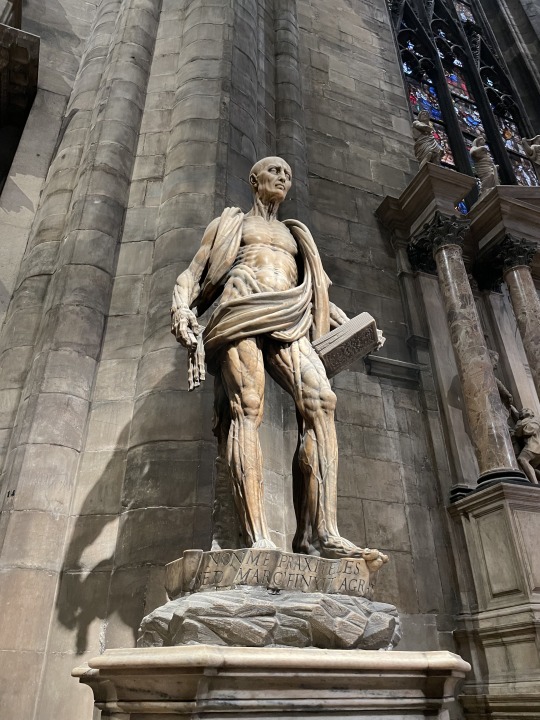


The next morning Allan and I ventured out for a short walk which ended up extending over 6kms around a rather high hill. We walked up high enough to see the sky above the mist – the first and only time we would see blue sky during this trip up north. It was magical walking through the deciduous forest with the ground covered in leaves.


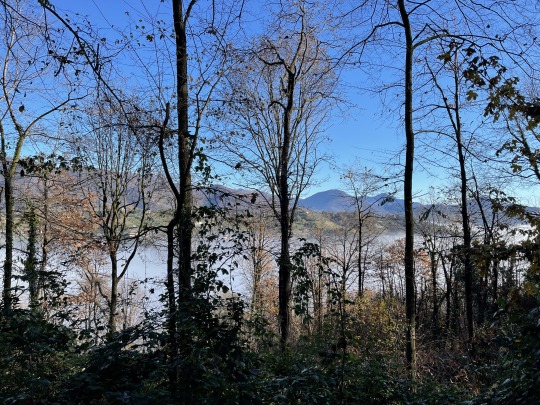
Later on in the day, we ventured in to see the Centro Storico of Bergamo. Again, we encountered misty weather which served to make the visit quite mysterious and fantastical.
Bergamo’s origins are ancient and can be linked back to prehistoric times. A perusal of the information currently available on Google indicates that Bergamo was home to many different tribes and peoples including the Etruscans, the Gauls, the Romans and even Attila’s Huns, the Longobards and the Byzantines.
Situated on a hilltop at the foot of the pre-Alps and overlooking the flatlands, Bergamo offered a strategic natural stronghold for its occupants. For a time it was held by the Viscounts of Milan until 1428 when it fell to the Venetians. The Venetians rebuilt the old city and erected imposing defensive walls. They installed Bartolomeo Colleoni, a powerful mercenary and Captain-General of the Republic of Venice and a member of the Colleoni family of Bergamo. Colleoni’s coat of arms which is engraved on the gates to the private family chapel features three ‘balls’ or testicles. It is said that Colleoni suffered from being orchitic and that he did indeed have three testicles, something he was very proud of. Legend has it that rubbing the balls on the gates to the family chapel brings one luck.
Colleoni was reputed to be a vicious and violent ruler (do correct me if I’m wrong). Mind you, he didn’t have to do much to protect Bergamo as it was impossible to get close to the city without being seen. The Milanese didn’t even try to use force to reclaim the city; instead, they offered Colleoni more money than the Venetians to try and gain his support. On his part, Colleoni used each offer from Milan to bargain for even more money from the Venetians who were very willing to pay more in order to retain control of the city. Bergamo was very important for Venice as it overlooked the most accessible passage into northern Europe and controlling the city offered the best protection for this trading route.
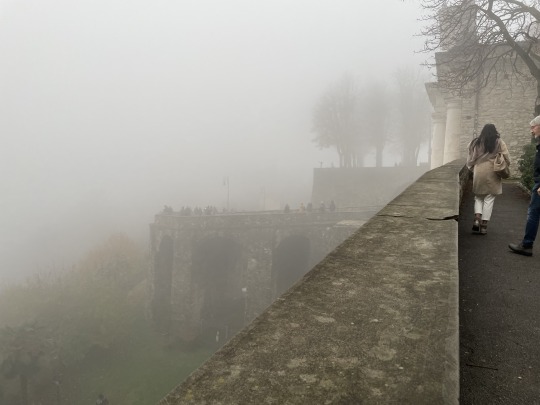
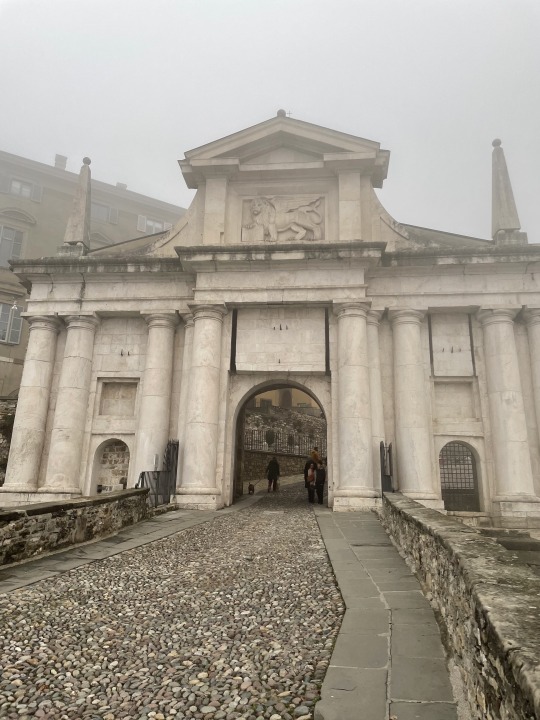

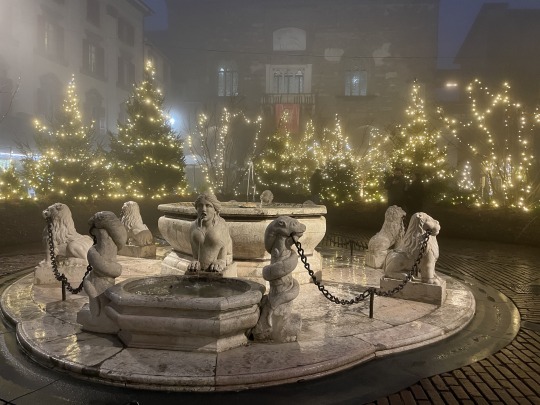


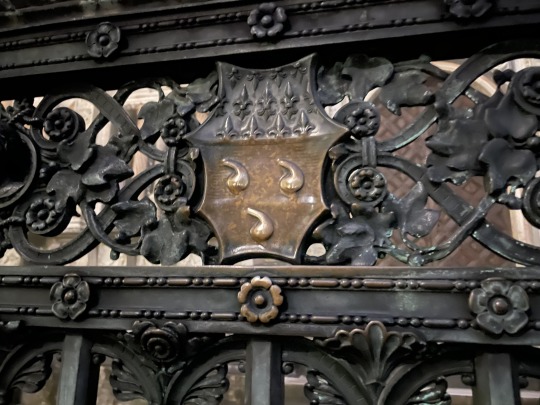
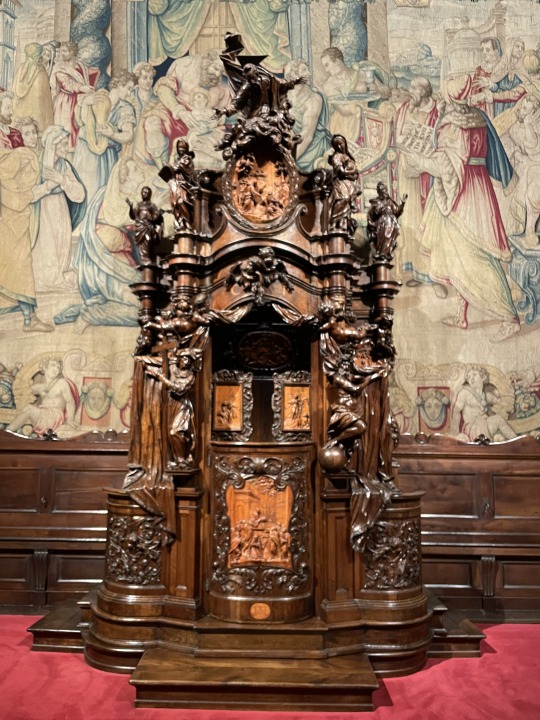


San Paolo d’Argon
While staying at San Paolo d’Argon, we joined a guided tour of the old Benedictine Monastery which now functions as a school. The monastery was initially founded in the 11th century and reconstructed in the 16thcentury with perfectly proportioned and clean lines. The old refectory features frescos painted by Giovanni Battistia Lorenzetti (painted in 1624). The reconstruction of the adjoining church which continues to function as such, commenced in 1684. The complex survived the suppression of the monastery and confiscation of its assets by Napoleon in 1797. The site is beautiful and certainly worthwhile visiting.



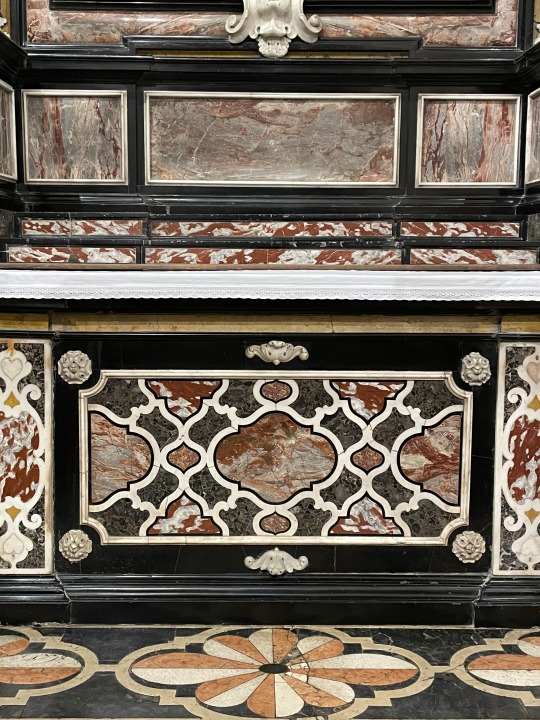

Traveling back to Le Marche
Okay, this time we made sure that the GPS was leading us back to Sassoferrato - Genga via the autostrada – about 90kms shorter and a hell of a lot faster than travelling over the mountains. The autostrade here are very impressive with regular tunnels traversing right through any mountains and hills along the route.
We were getting hungry and tired and so we stopped at Serra San Quirico, a fortified medieval village set on a rocky outcrop on the foothills of the Apennines. This was another fascinating village to wander through, especially with its ‘copertelle’ or covered alleys above the city walls; apparently these once served as walkways for solders to protect the town. We didn’t get a chance to visit the secret passageways or 12 watch turrets; perhaps an adventure for another day.
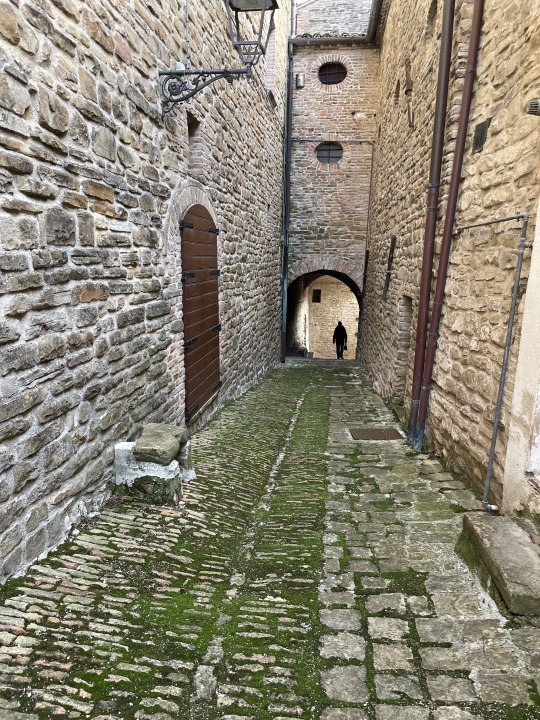

2 notes
·
View notes
Text
A Sojourn in Italia - Day 57
Well I started this blog with the intention of writing every day or so. You can see how well that worked out. Various things got in the way and the time seems to pass so fast. It’s hard to believe that we’ve now been here for 57 days.
We’re currently in Chieti, which is a small city about an hour west of Pescara which is in the Abruzzo region. Our stay is a small converted loft area in a building a little way out of town. The apartment is quite small but clean and adequate for a few nights.
We arrived here on the 30th driving down from our stay near Sassoferrato (or search for Fabriano if you want to find it on a map). We drove via an inland route, avoiding the Autostrada for a while to pass through various little towns in what is largely a farming region. The roads were no more challenging than near our base. It’s true what is said about the roads in Southern Italy. They are a bit rough and one needs to keep an eye out for potholes. The patchwork quilt approach to repair is obvious - I should take a photo at some stage. But they are workable and no more difficult than many NSW roads near Canberra. The Renault Captur is proving to be a good car for the journey. Although only a front wheel drive, small SUV, it’s small enough to navigate small roads but large enough to withstand the occasional pothole that we don’t avoid. Both Luisa and I cannot see the front as it slopes away and judging the wheelbase is tricky sometimes - “I’m sure I swerved enough to miss that pothole, but…”.
The day we arrived, we decided to do our usual “lets walk and see if we can find the city centre”. We started off in the wrong direction - hmm. Then we discovered that we were further out than we thought. It’s only about 2.6Km to the centre and only a 200m climb, but someone forgot to put in marciapiedi (footpaths). We found ourselves on a busy road and much of the time without any option but to walk on the side of the road. And the climbs were steep. We walked home largely in the dark - did I mention how quickly it gets dark here. I know that its winter but I still find it quite a shock to realise that there is little twilight.
Yesterday we worked out the buses and caught a bus to the centre. This was a bit of an eyeopener as we recognised the steep climbs we’d undertaken the day before which the bus was clearly taking slowly in a low gear. No wonder our feet had been sore.
We visited the Museo Archeologico Nazionale La Civitella. This was an amazing place, so well organised with finds from the Paleolithic period through to medieval times. A period covering some 6,000 years. It really became quite overwhelming, there is so much there. They’ve done an amazing job of putting pieces together and using fired clay to recreate missing pieces (clearly shown and not trying to pretend to be the original). What it lets you see is how pieces came together. This is especially valuable when your looking a pieces that pre-date classical Greek influence and the worship of earlier Gods and Godesses. Chieti is believed to be one of the most ancient cities in Italy.
We got out of the museum about 1:00 which made finding a place for some lunch a bit of a challenge. Quite a few places are closed (either for the period or perhaps permanently post the impact of Covid) and of course it was Capo Danno (“Years End” to be literal). We were almost ready to give up when we found a little place on a side-street that was a bit of a catch all place that is hard to define. Amongst other things it serves “Fast Lunch”. We had a “Pranzetto” which was the only thing they were serving. Imagine a high-tea multi-sectioned platter (what do you call those things?) with a selection of savoury items. That with a glass of Prosecco was just what was required. Il cameriere (the waiter) got chatting to us (well mainly to Luisa because she can respond) and talked about the ancient battles between Chieti and Bucchianico (7Km away), his home village.
Today is of course the the 1st and most things are closed. After a short walk we found a bar open at the bottom of the street. Probably the only one for miles around, but also serving those who’d been to the church across the road - it is Sunday. We then decided to visit Bucchianico, the place the waiter had talked about as there was little else to do - its a public holiday and Sunday - so very little was open. A nice drive through some very narrow winding farm roads. We explored the town, had a coffee at a bar and then returned back to our stay. Now the question of lunch arose.
We had passed a restaurant on our first day when we started going the wrong way. This claimed to be a fish specialist, but seemed isolated and out of the way. We were a little unsure as it seems connected to a fast food takeaway across the road from us (which is closed today). Needs must, so we walked up the hill on the off-chance that it was both open and had a table. Well did we misjudge that place. The owner was wonderful, the food fantastic and we had a leisurely lunch over a two hour period. The owner/waiter was a brilliant up-seller who talked us into having a seafood antipasto before a baked mixed seafood platter along with wine and desert. The fish, scampi, and stuffed calamari were top class. And yes we’re skipping dinner tonight.
Tomorrow we take off down the coast to a little seaside town called Trani for a couple of nights before going to Lecce.
I’ll try and add some general photo’s later (or more likely repost Luisa’s).
Until the next post (which hopefully will be sooner rather than later),
a dopo (to later).
3 notes
·
View notes
Text
Buon Natale Tutti
Buon Natale tutti (Good Christmas Everyone). Hope you all enjoy a great day.

0 notes
Text
A Sojourn in Italia - Mobile Phones for I Stranieri
This is a little extra for interest and perhaps useful for someone in the future, about i piani cellulari.
No doubt working out mobile options while visiting Italy seems to be one of the more complicated and confusing things and I still don’t get all of the details of how it all works. So while what I’m about to say should be reasonably accurate, check things out at the time.
Some Background:
Italy has 3 main mobile phone companies (actually 4, but the new one is still building coverage). The main three are TIM, WindTre and Vodafone. (Iyiad is the new kind on the block). DO NOT go with TIM. TIM is Italy’s answer to Telstra and we used them last time. Somehow despite having an all in one 30 day plan, we kept running out of credit because they kept sending us SMS’s which used the base credit on the plan and hence made the 30 day plan inactive until we added credit. (Well this is the best sense I could ever make about what was happening.) In Italy the receiver pays for the SMS charge!
In Italy all contracts must utilise a “Codice Fiscale”. Basically a cross between a Tax File Number and a US style Social Security Number. Obviously as tourists we don’t have this. Therefore the phone companies have special plans that are only available for tourist’s. (Usually listed as something like “Offerte Estero” - offers for foreigners). They use your passport details to satisfy legal requirements.
Our Current Plan:
We asked our hosts about best coverage and she suggested Vodafone as being most reliable - we are out of the major cities so… So we went with them. I’ll come to our plan in a minute but before hand give a little story to serve as a warning. I expected that the Vodafone stand at the airport would be the most reliable way to sort out a plan. The assistant spoke good English and offered two plans that would meet our needs. We signed for the slightly larger plan as it’s only €2.00 more per month. The charge for setting this up is entirely at the shop’s discretion. In this case we payed €55 each which covered the SIM, the first month and their fee. The assistant set things up and told us to wait for the SMS’s in about 2-4 hours and then reboot our phones. We then received a little bit of paperwork and were on our way. Except when we finally got the SMS’s and rebooted the phones we realised that we had not been given the actual phone numbers applying to the SIM’s. We thought they were on the paperwork we’d been given but they weren’t. So we found a nearby Vodafone franchisee near Trastevere in Rome who tried to tell us that we either had to go back to the airport (an hour away) or set up a complete new plan with him. Sensing a scam we took a long walk to find another Vodafone franchisee who was very helpful, looked up the serial numbers of the SIM cards and wrote down the phone numbers for us and explained more of how it worked. (And refused to take anything from us for his trouble.)
Now here’s another area of confusion. Vodafone kind of expect that you use their App to manage the plan, including checking credit and adding credit each month. BUT, the App is geo-locked. The Apple App store will not allow us to download the App unless we change our App store (which is different to your region setting etc which we’ve already changed). You can only change your Apple App store once a year and must cancel all existing Apple subscriptions (we utilise Apple One so this is a definite NO!) If you’re an Android user you mileage may vary, but for us it means we cannot get the Vodafone App. (Why do they geo-lock an App that tourists are expected to use?)
Not to worry, finally, at the end of the month, we received a text from Vodafone telling us to ensure we had enough credit on our phones for the renewal of the plan in the next couple of days. We dropped into a Vodafone store in Bolzano, they looked it up using the phone numbers and charged us €10 each to add the Credit (€9 + €1 service charge by them). If you can’t find a Vodafone franchisee, each of the Tabacchi’s are meant to be able to do it. Tell them your company and phone number.
So what is the plan we are on? It’s called the C’all Power plan. It gives us 70 Gbytes of 4G data (5G is not on this plan yet but is common in Italy) and unlimited calls. Ostensibly it costs €8.99 per month. We also have 300 minutes a month to several countries, although I think calls to Australia can only be to landlines, not mobiles (this is one of those grey areas). I think we’re also allowed to travel into adjacent EU countries and have some coverage, but I think it costs something like €3/day extra.
As for ongoing travel, I doubt that there’s any really economical plan that is worldwide. Roaming charges are ridiculous. the only thing I can see that’s reliable is to get a local SIM on the best plan possible in the country your visiting and change your number for each country. There may be a EU wide plan, but I haven’t found it yet. It does exist for EU based plans but they are not the same as our tourist plans so… I think Vodafone UK used to have a plan that covered the EU for a time but post Brexit, I’m not sure how that works.
Hopefully this information is useful,
1 note
·
View note
Text
Once again I’ll reblog Luisa’s blog post.
I’ve got a head cold (negative RAT) and so a little out of it the last couple of days.
Veneto
On day 6 of our trip north we made it to Thiene, Veneto, a beautiful town at the foothills of the Italian Alps, just north of Vicenza. This was an opportunity to visit and reconnect with my cousins on (Dad’s side of the family), my aunt, and with Laghi, the small village from which my family emigrated many years ago.
Staying in central Thiene meant we could wander into the old town centre, past the Palazzo Porto Colleoni (built in the 15th Century), the Baroque style Cathedral, the old Romanesque-gothic church which dates back to 1333, and just experience the ambiance.
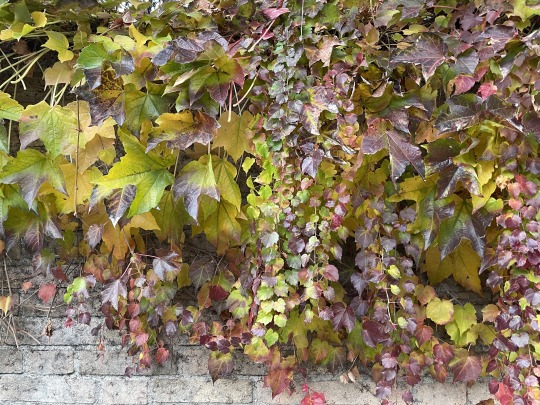


One afternoon we went for a late afternoon walk around the hills above Carrè which is north of Thiene and at the foothills of the mountains. We were greeted with stunning views over to the Gruppo Delle Piccole Dolomite, the Gruppo Pasubio and Monte Maggio.



The following day we were invited to join a group of Brazilian tourists for a history tour of Laghi. We met the group at the local trattoria in Laghi which is famous for its potato gnocchi and, after a good coffee, we headed off to the Molini contrada.
A little background information: Laghi is Italian for ‘lakes’ and we can probably attribute the name of the town to the existence of two small lakes in front of the main piazza. Laghi is Veneto's municipality with the smallest number of inhabitants and the lowest density. It comprises a number of small hamlets, or contrade, scattered over the valley and surrounding mountain side. The Molini contrada can be found behind the main piazza, at the base of Monte Maggio, one of the mountains which tower over the piazza. Monte Maggio lies next to the Pasubio group of Dolimites and the border of the Veneto province runs across the top of Maggio and over to Pasubio. Up until WWI, this was part of the border between Italy and Austria and during the war, it formed part of the Italian front along the Dolomites and Alps. I grew up hearing Mum’s stories of how the whole town of Laghi was told to evacuate one day, probably for several weeks and the war raged. They were able to return several years later to find the whole town devastated from the bombing.
Our tour of Molini was more focused on other aspects of living in Laghi during a time before the wars when everyone was largely reliant on the land. Interestingly, our guide advised us that no one went hungry during those days, with food being available from what they produced from the land, local products and flour and sugar bartered or bought from neighbouring towns.
We toured the old community cheese making ‘workshop’ in Molini where much of the equipment has been maintained. There used to be a number of these small community workshops spread across Laghi, including one where my grandfather, Giuseppe, made cheese with milk provided by the nearby families. Who would have known that cheese making was such a strong part of my family history! I asked what types of cheese were typically made and the response included Asiago cheese (a favourite of mine to make). Rather than press the cheeses they let them drain naturally and they used the leftover whey to make both butter and ricotta.
We also toured the old sawmill and viewed the old hydro system set up by a local to generate electricity which he then sold to the community. The latter was a very innovative initiative which the local set up and ran prior to the availability of electricity from the national grid. The system is still functional after all these years although it no longer supplies the community.
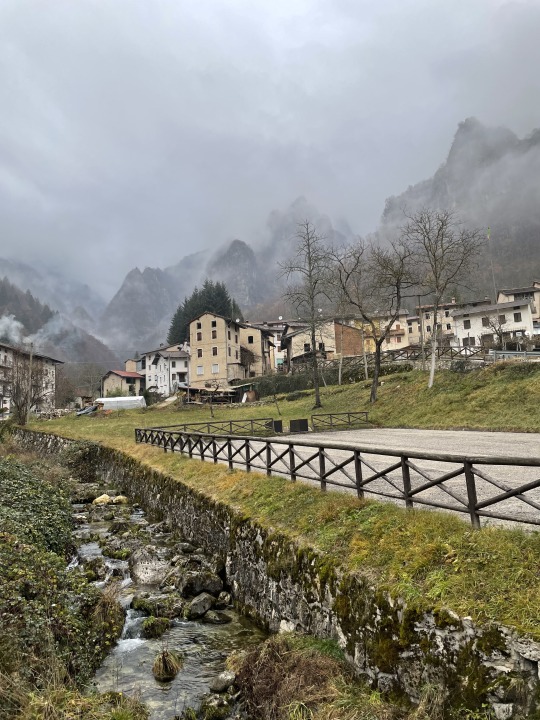
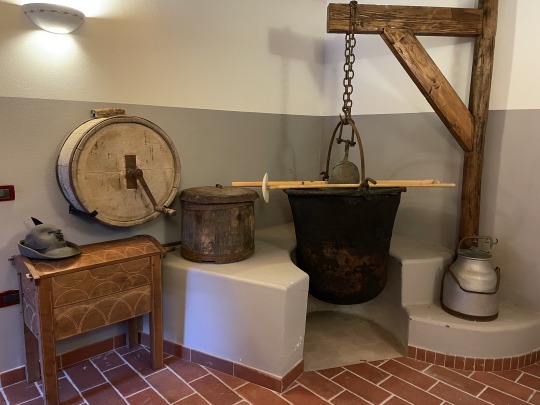
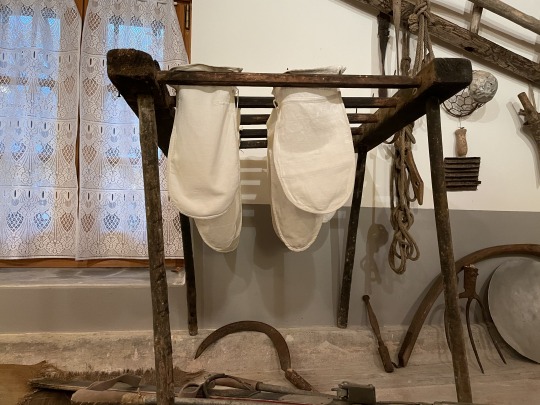

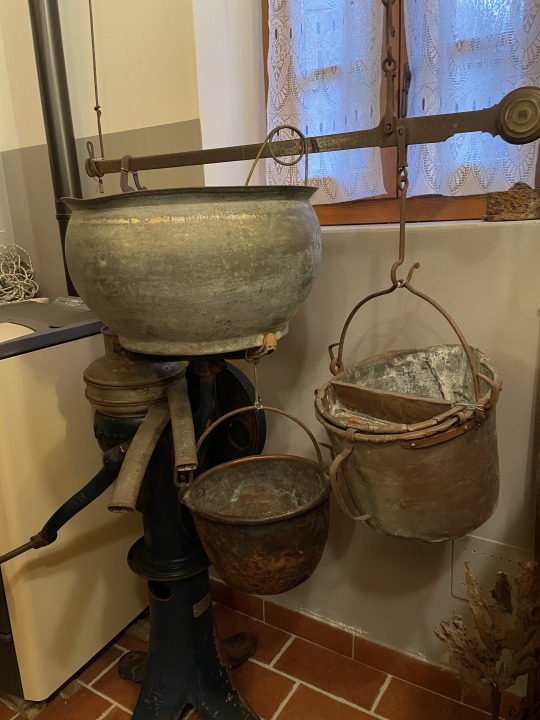
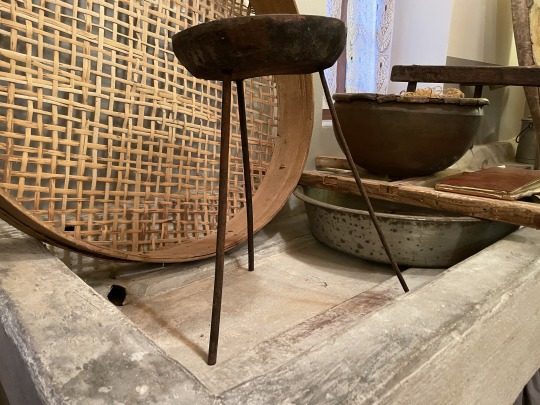


A little background information: Laghi is Italian for ‘lakes’ and we can probably attribute the name of the town to the existence of two small lakes in front of the main piazza. Laghi is Veneto's municipality with the smallest number of inhabitants and the lowest density. It comprises a number of small hamlets, or contrade, scattered over the valley and surrounding mountain side. The Molini contrada can be found behind the main piazza, at the base of Monte Maggio, one of the mountains which tower over the piazza. Monte Maggio lies next to the Pasubio group of Dolimites and the border of the Veneto province runs across the top of Maggio and over to Pasubio. Up until WWI, this was part of the border between Italy and Austria and during the war, it formed part of the Italian front along the Dolomites and Alps. I grew up hearing Mum’s stories of how the whole town of Laghi was told to evacuate one day, probably for several weeks and the war raged. They were able to return several years later to find the whole town devastated from the bombing.
Our tour of Molini was more focused on other aspects of living in Laghi during a time before the wars when everyone was largely reliant on the land. Interestingly, our guide advised us that no one went hungry during those days, with food being available from what they produced from the land, local products and flour and sugar bartered or bought from neighbouring towns.
We toured the old community cheese making ‘workshop’ in Molini where much of the equipment has been maintained. There used to be a number of these small community workshops spread across Laghi, including one where my grandfather, Giuseppe, made cheese with milk provided by the nearby families. Who would have known that cheese making was such a strong part of my family history! I asked what types of cheese were typically made and the response included Asiago cheese (a favourite of mine to make). Rather than press the cheeses they let them drain naturally and they used the leftover whey to make both butter and ricotta.
We also toured the old sawmill and viewed the old hydro system set up by a local to generate electricity which he then sold to the community. The latter was a very innovative initiative which the local set up and ran prior to the availability of electricity from the national grid. The system is still functional after all these years although it no longer supplies the community.
A little add-on for Allan and myself was a tour of the Comune Di Laghi and the council chambers. We saw the list of sindaci (mayors) from 1872 to 1999, including my grandfather (Guiseppe Dal Molin) and uncle (Attilio Dal Molin). Thank you Allan for the photos ….
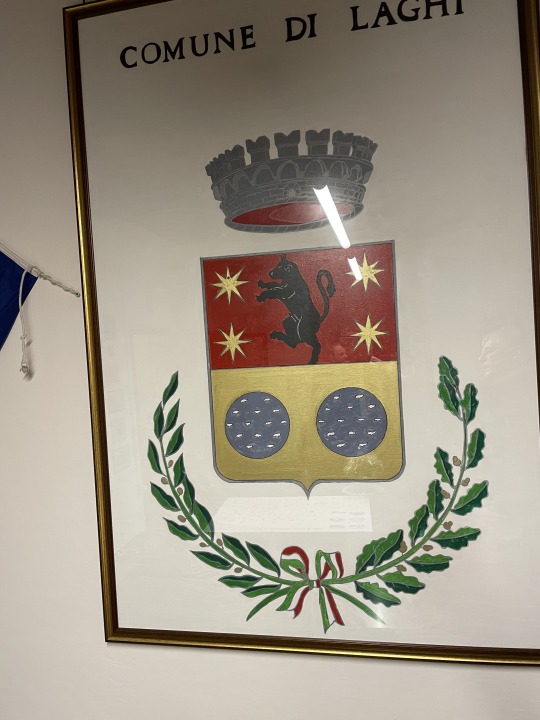
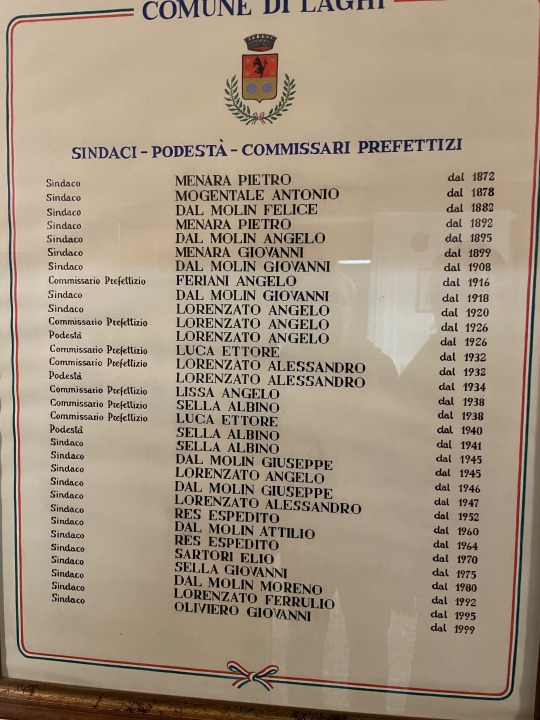
Back in Thiene, one of our last stops during this visit was to a local nursey which transforms into a Mercatino Di Natale each year. The displays were wonderful, with each section featuring a different colour theme for the tree and decorations. It was only the thought of minimal suitcase room and arriving back in Australia with a big box of broken glass that stopped me from buying a selection of baubles. Instead, I’ve set up a Christmas Table with two gnomes which a cousin has handmade (they are absolutely stunning), candles and books we’ve been given along the way. Now we’re back in Le Marche. Time to get back into walking and getting ready for next year. Damn, it’s raining again … think I’ll make a torta and curl up on the couch with my knitting.
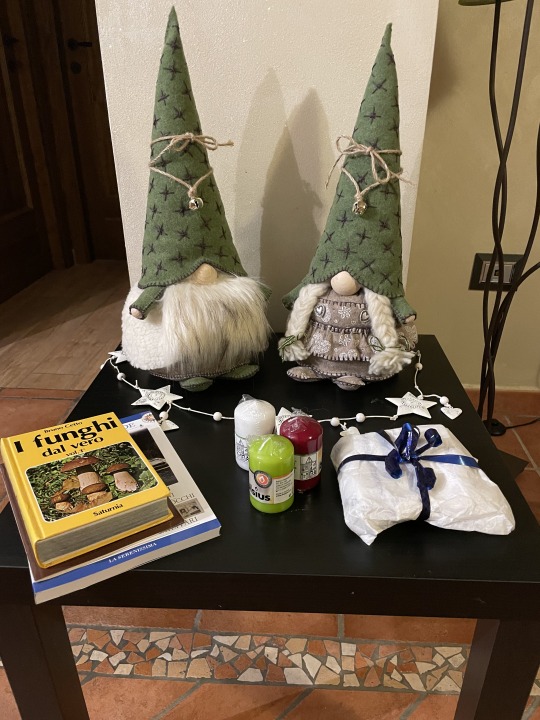
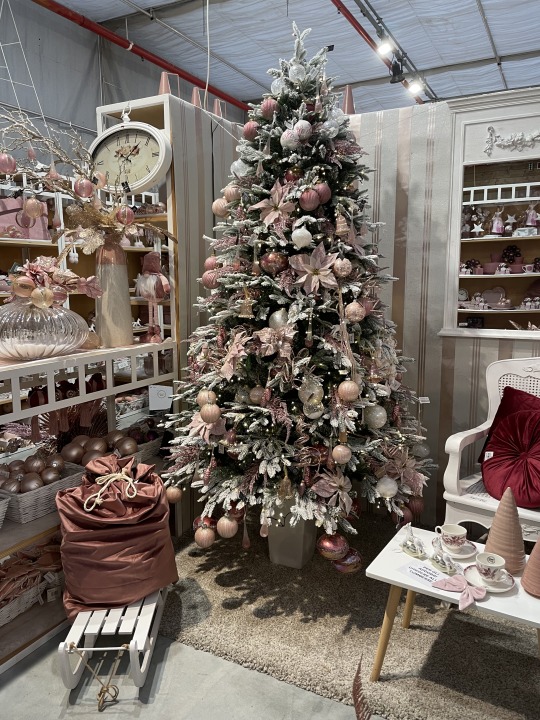
2 notes
·
View notes
Text
I thought I’d reblog Luisa’s post about our time with family. (This is only the first half). I thought I’d be able to blog while away, but the reality is that it was full on.
Luisa is going to blog about the second half tomorrow, so I’ll reblog that too.
I’ll get back to my own blogging efforts soon.
8 dicembre – Back ‘home’ in Le Marche
Well we’re back in Le Marche after visiting my family up north. It’s been a wonderful trip with quite a few adventures experienced over ten days. There is so much to describe that I’ve split this update into two posts: the first will touch on our visit to the Trentino–Alto Adige region; the second will cover our visit to Veneto.
NB: In order to protect the privacy of family members, I am not including their names or photos in my blog, other than Allan that is.
Trentino–Alto Adige
The Trentino-Alto Adige province of Italy is the northern most province of Italy – it’s the province of mountains including parts of the Dolomites and the Alps. The province is bounded by Austria and was, in fact, part of Austria prior to WWI. Something I hadn’t known before this visit was that Italian was the language most commonly spoken in the Trentino region, even when it was part of Austria. In contrast, German was the language of Alto-Adige and it remains an important language in this region.
My family here is linked to Mum’s two older sisters who had moved to Brentonico for work soon after WWII. Zia Angelina was 16 and Zia Maria must have been around 14 when they left Laghi to travel to this beautiful village high in the mountains between the Adige valley and Lago di Garda. And in all likelihood they walked over the mountains to get there.
Travelling to Brentonico was our first experience of driving on the autostrada during this trip. Allan loved it! He very quickly got the hang of travelling at 130kms/hr and zipping past trucks and slower cars. It was, however, very disconcerting to have cars whizzing past us at times, likely traveling at 150km/hr or more.
In total we spent 4 lovely days in Brentonico, visiting family and seeing some of the sites. We had a series of wonderful meals, good wine, and cheese (the gorgonzola with mascarpone cheese is ‘to die for’). The company was delightful each time; we shared many laughs together and stories together.
In the interests of keeping this blog to a manageable length, I’ll list just some of the adventures we experienced on this part of our trip.

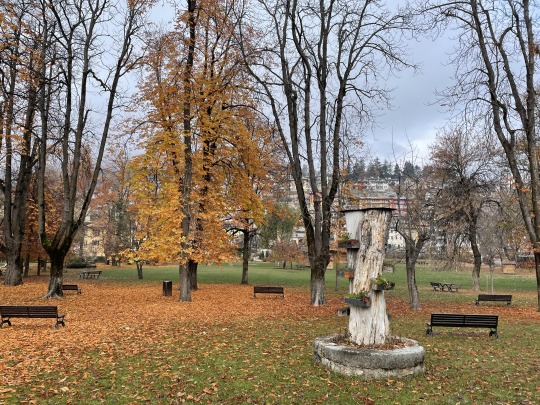

The Mercanti di Natale
We had the chance to visit two Christmas markets during our stay, including the famous Mercatino di Natale in Trento. It was a magical experience exploring the Christmas stalls, drinking Brulé and taking in the Christmas lights.
The second Mercatino di Natale was at Bolzano – we wandered through these markets several times as we found our way around the centre of Bolzano. German is the most common language spoken in this part of Italy which led to some interesting experiences interacting with others and ordering some lunch.

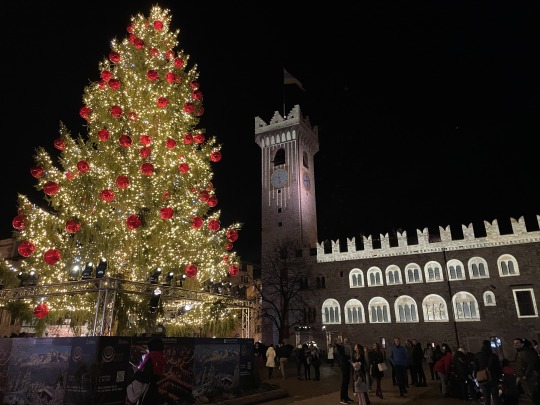
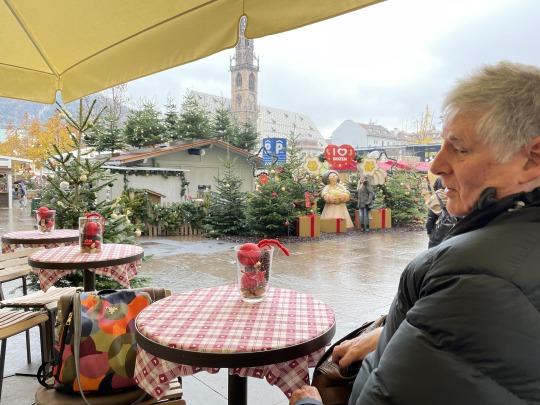
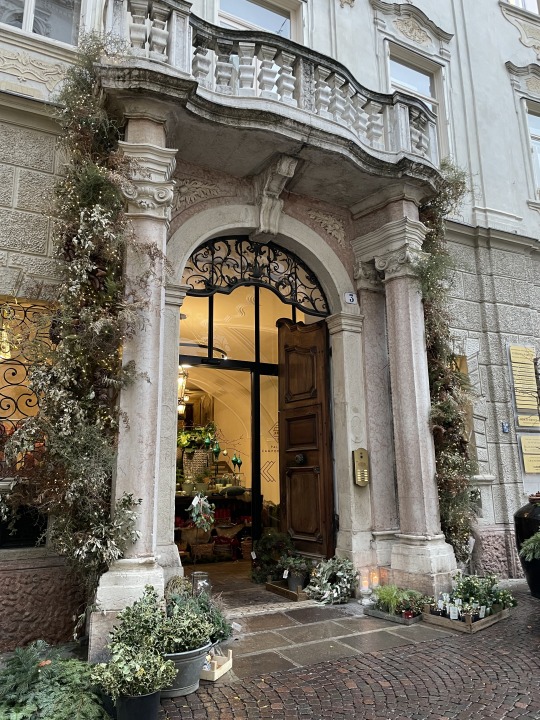


A day in the snow
On Sunday we joined one of my cousins and his family on a snow sledding day. In the morning we made our way up to the top of Monte Vignola through snow that, at times, reached our knees. After a delicious picnic and hot coffee in the refreshing wind on top of the mountain, we made our way down the other side of the mountain; the three teenagers going down on their sleds while the adults walked and, at times, slid down on their backsides (I think that was just Allan and I). I did hitch two rides with one of the teens which while a bit scary was also a lot of fun. The second ride was towards the bottom of the mountain and quite steep so we went down very fast. We were almost at the bottom when we hit a section of soft snow - the sled slammed to a sudden stop and I went flying forward landing face first in the snow. Thankfully no one was around to take any photos of me sprawled, like a back-to-front snow angel! It was hilarious and it took some time for me to stop laughing (and to get my glasses cleared and the snow out of my shoes).
And to finish off the day: another delicious meal which started with canederli (bread and speck balls cooked in broth, a dish I love and will make again when we get back to Australia) and a delightful ‘concert’ put on by two of my younger cousins who are learning to play the piano accordion.

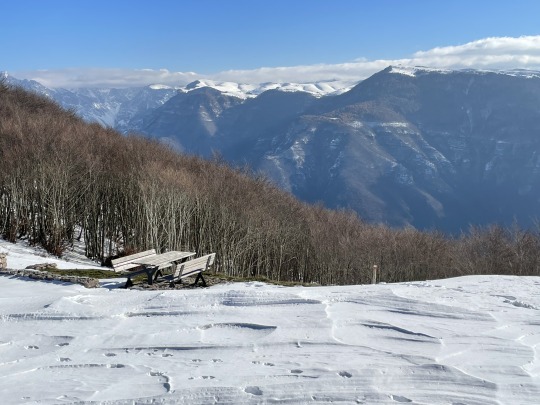


A visit to see Ötzi, the ‘Iceman’
The following day we joined another cousin on a day trip to Bolzano by train. Allan and I took the opportunity to go and see Ötzi, also known as the Iceman, at the Bolzano Museum of Archaeology. Ötzi lived sometime between 3,350 and 3,105 years ago and his mummified remains were discovered in Sept 1991 in the Ötztal Alps which are located along the border between Italy and Austria (there was some consideration about in which country he had been found, but careful border investigations proved that his remains were found 100 metres in on the Italian side of the border). The exhibition is certainly worthwhile seeing if you’re ever in Bolzano; you can see the remnants of Ötzi’s clothes, backpack, snowshoes, and weapons, along with some very useful information derived from successive analysis of the mummy over the years. This has uncovered a wealth of details about his diet and last meal, where he likely lived, previous injuries and the state of his body at death including his teeth.
We eventually also found the mummified body which can be observed through a small window. The parallel lines which had been tattooed into Ötzi’s legs were clearly visible; apparently 9 out of the 19 groups of tattoos found on the body correspond to acupunctural areas that are used today while most of the other groups are on meridians, other acupunctural areas of the body or over arthritic joints. Keep in mind that Ötzi lived abut 2,000 years before the previously known earliest use of acupuncture points in China.

Rovereto and the Campana dei Caduti
I have visited the Campana dei Caduti (the Bell of the Fallen or ‘Maria Dolens’) several times on previous visits to Rovereto but this visit touched me very deeply. It was a local priest, Don Antonio Rossaro, who shortly after the end of WWI had the idea to construct this massive bell as a way to remember all the fallen. The original bell was cast with the bronze of the cannons of the nations which had participated in the Great War and was inaugurated in Nov 1925. The bell has been recast several times since then, including in 1960 after a serious and irreparable crack appeared. The current bell was cast in 1965.The Campana dei Caduti is the largest bell in the world to sound at full peal and it rings out 100 times each day at dusk “as a testimony of world peace”; hence my sadness as humanity hasn’t yet been able to work out how to achieve and maintain world peace (or a world free from hunger).
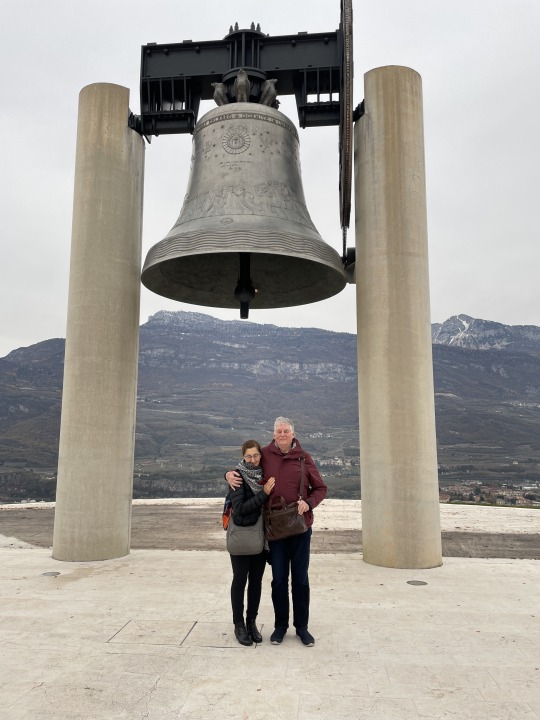

3 notes
·
View notes
Text
Day 21 - A sojourn in Italia
Today the weather was beautiful day. The sun was shining and the skies were blue with just a few clouds in the sky and a light breeze. However, the electricity went out at about 9:00 and didn’t come back on until about 2:00. So we drove to Sassoferrato for a coffee and pastry and to purchase a few things. Luisa then walked home from a turnoff near the road to our house. I drove home, unloaded the car and made myself a tea - sitting outside in the sun.
In the afternoon, Luisa baked una torte di mela (an Apple Tea Cake) to take with us tomorrow. In the meantime I tried to create an account on the Telepass App and register the device for the tolls. The first problem, they want to send an SMS to the phone number for an account, but our plans do not allow for receiving SMS’s. We tried calling them, but our Italian (even Luisa’s Italian) was just not enough to solve the problem. The telephone assistant tried to give us details of a place in Ancona (an hour away) where we could get assistance, but even getting the address was difficult - besides it’s out of our way somewhat on a long journey tomorrow.
So next we asked our wonderful host to assist us. He tried to call the assistance number, but they were then having technical difficulties. So trying again using his number came up against the need for a Codice Fiscale (a bit like our TFN, but closer to the American Social Security number in practice). Anyway neither of us have a Codice Fiscale. In theory we should be able to do this using our Passports but how is unclear and the App does not make an allowance for that. So for tomorrow, we will be ensuring we get into the right lanes for paying tolls - several times. Qualunque cosa sarà sarà (Whatever will be will be).
I probably will not get to post tomorrow. It’s going to take 5-6 hours to get to Brentonico.
Time to pack,
Scriverò quando sarà possibile, probabilmente sabato. (I will write when next possible, probably Saturday).
ciao
2 notes
·
View notes
Text
Day 20 - A sojourn in Italia
Ciao Tutti,
I said yesterday that “arriva l’inverno”. Well as we drove out toward Perugia this morning we were greeted with vistas of the distant mountain tops covered in snow. Unfortunately there was nowhere suitable to stop to take a photo, but if you look closely in the background of the photo(s) looking eastwards from Perugia, you can see the snow capped peaks under the clouds. All very beautiful.
Luisa did an excellent job of working out where we could park for free and how to catch the “MiniMetrò” to locate the Tabacchi to get the Telepass device for the car. Finding the Tabacchi was a bit of a challenge. If a genitle persone at a bar had not given us directions we may never have figured out that it was out the back of a building. But we found it and then Luisa suggested that we again catch the MiniMetrò to the historical centre. I suggested that as it was only about 1.2Km that we should walk. Mio Dio, what a good idea that was - that was 1.2Km straight up and up and up and…
We found the main piazza and wandered down via the markets to a vista over the valley below before wandering back to visit the “Galleria Nazionale Dell’Umbria” (I guess Victoria is not the only place to have a local “National” Gallery). It’s a wonderful gallery contained within the Palazzo dei Priori. We think we were the only visitor’s at that time which made for a wonderful meander through the galleries with the ability to take it all in, but seemed such a shame for such a wonderful collection dating from the 1200’s through to the present to have so few visitors, even if it is out-of-season.
Afterwards we found a lovely little restaurant hidden down some stairs in an old building off the main piazza. This was definitely not a lonely place with many locals and some obvious regulars eating lunch. So we’re kinda skipping dinner after having filled our bellies with a lovely wood fired Tartufo pizza (Tartufo = Truffle), 1/2 a litre of a lovely slightly spritz vino bianco (white wine) and a bottle of mineral water all for €29.00. The pizza’s were generously covered with slices of Tartufo and were wonderful. I absolutely love the pizze bianche (that’s pizza’s without a tomato base).
We returned home and after some minor struggles with our GPS - “no I’m not turning left here, the sign clearly says no entry that way” we got home a little after dark - the days are so short now already.
well until next time,
a domani (until tomorrow)






2 notes
·
View notes